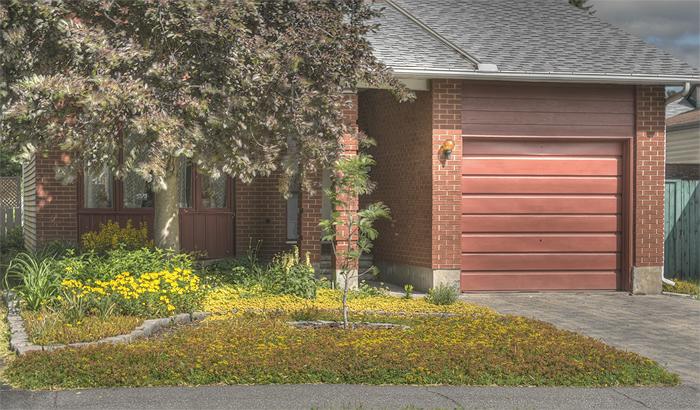
the front garden June 2012
I moved winter 2005 to be near to grandchildren (Ottawa, zone 5a Canadian, 4b USDA) and decided that now, given the time freedom of retirement and the incredible information and purchasing resources of the web, was the time to make all my gardens my colour. The house faces south-east. Half the front used to be heavily shaded by an 11 m Prunus virginiana but it died due to black-knot fungus in 2021. Much of the rear garden is partly shaded by my house, a neighbour's house, and a row of 15 m Tilia americana to the north-west.
My ideal for a garden is a natural meadow: the only bare earth is where animals walk and dig - the only plants found are those that grow happily together without overt attention - there is always something in bloom somewhere - you are surrounded by nature. I especially value shallow-rooted ground covers that allow other flowering plants to grow unimpeded through them. In a natural meadow, plants intermingle and grade into each other - a suitable ground cover gives a similar effect for separated specimen plants. Such a ground cover also eliminates any need for artificial mulch, reduces weeding to a minimum, discourages squirrels from digging up bulbs, and softens the appearance of plants that are out of bloom.
This is the garden I share with passers-by. The focal view is from the sidewalk, moderately formal with a touch of drama, with at least one floral focus of interest throughout the year. There is a focal group of small plants in pots at the entrance of the walkway to the front door.
All plants on these pages have survived at least one winter here and have then bloomed. Plants that have proven themselves here for at least 3 years, and that I can recommend to other Ottawa gardeners, are in bold. Notes and photos will grow and disappear as the plants do. (Sadly, I've never found a remotely-yellow hyacinth that is hardy here; City of Haarlem starts off yellow but is almost white by year three.)

the front garden June 2012
mouseover thumbnails for full images
human
insect
| Allium moly from southern Europe was planted here a decade ago, and none appeared after the first winter. One popped up and bloomed June 2016! It's back up May 2017 & 2018. |
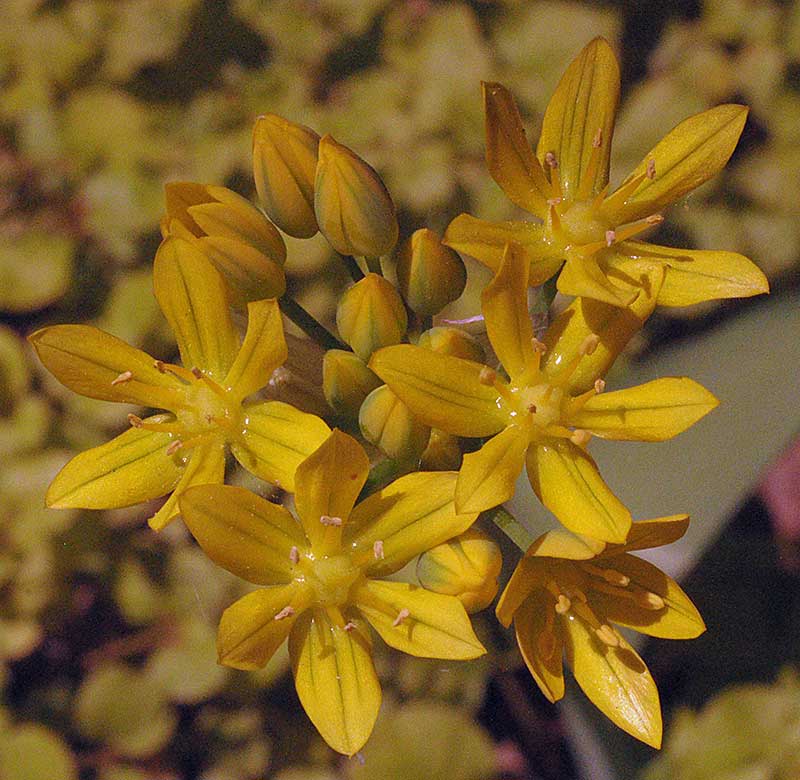

|
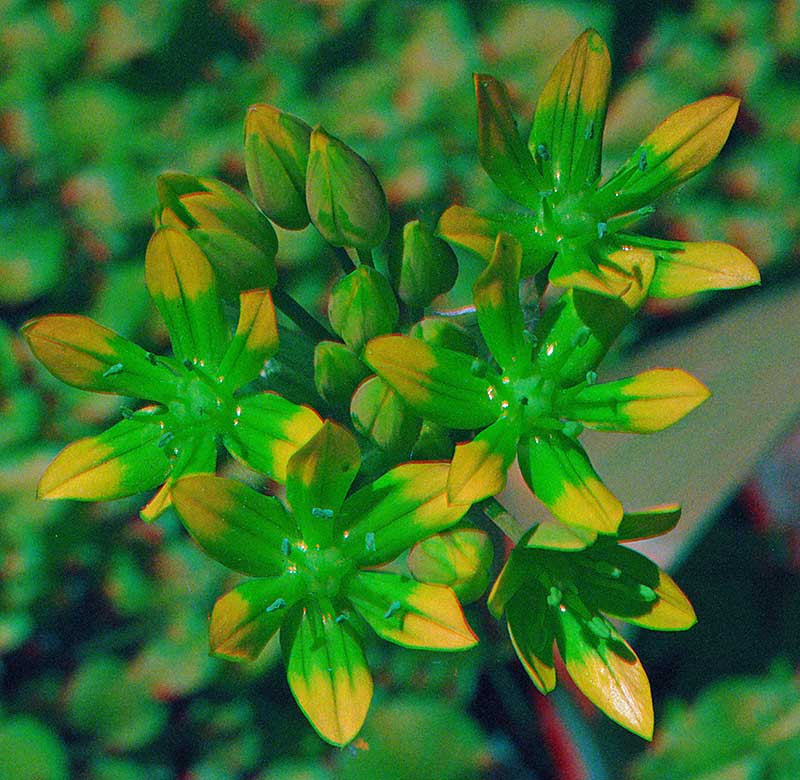

| |
| Anemone ranunculoides is from woodland Europe. Although it's supposed to prefer acid soils, it's spreading here nicely via underground rhizomes. It vanishes mid-summer so needs marking. 20% sun. |
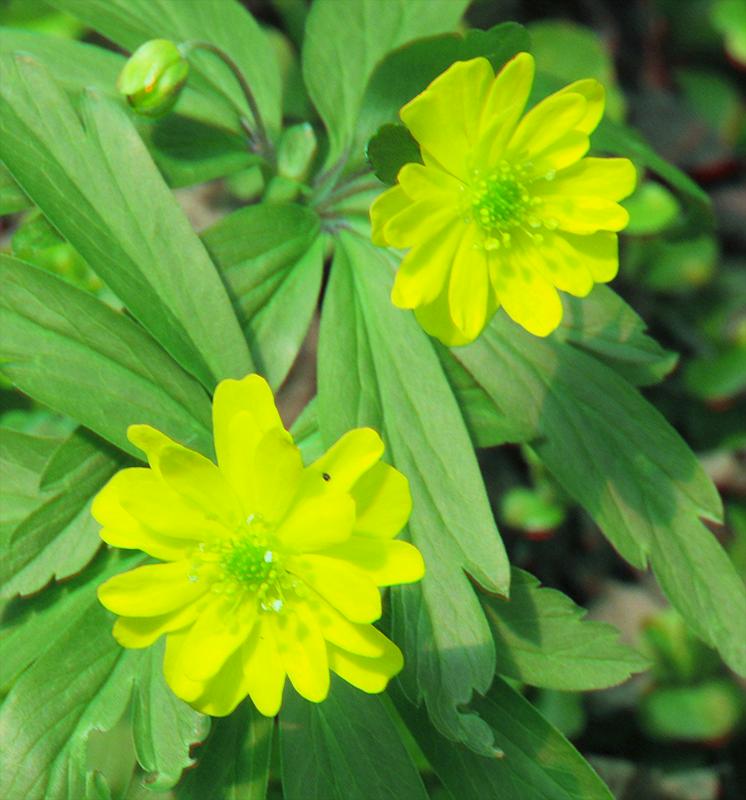

|
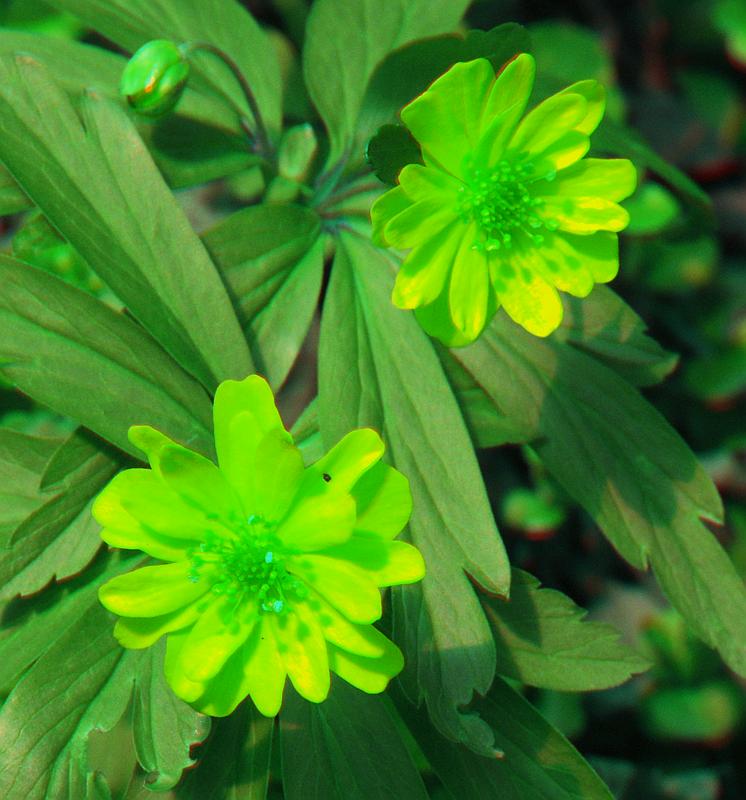

| |
| Chelidonium majus, originally from the Mediterranean, is naturalized locally in mid to deep shade. It stays green under the snow and starts growing as soon as days are above freezing. It puts on a great show in spring, but has a lot of seed heads to pick off if you want it to keep blooming through the summer; if you do, it blooms until hard frost. Unlike most woodland plants, it's happy in dryish soil. The orange sap that's exuded when the seed heads are removed is supposed to remove warts; flower diameter 27 mm; 15% sun. |
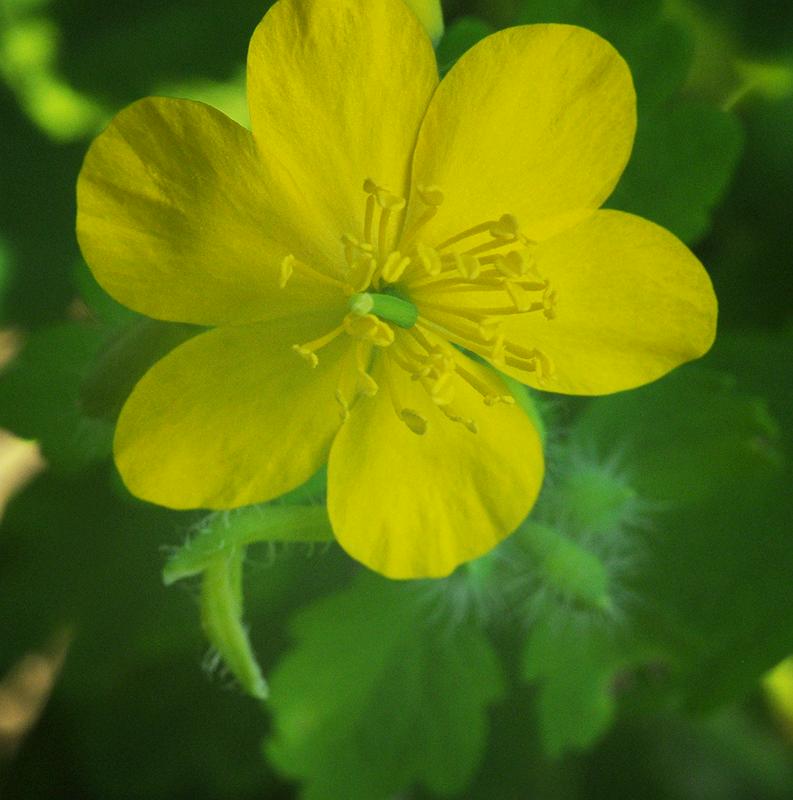

|
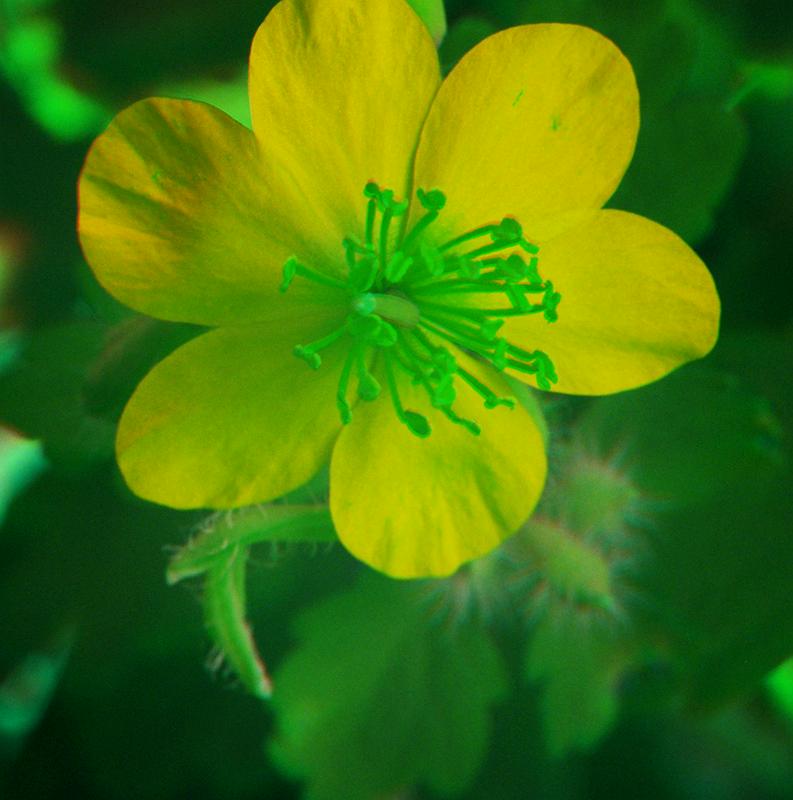

| |
| Chrysanthemum 'Yellow Quill', planted spring 2014, is the first yellow chrysanthemum I've found that survives winters here. Its rays could be fuller but in Ottawa you take what you can get! Its spent blooms need to be trimmed to keep it looking good. The 'insect' image here is contrast-enhanced UV only, the balanced image in UV is totally black; composite diameter 70 mm. |
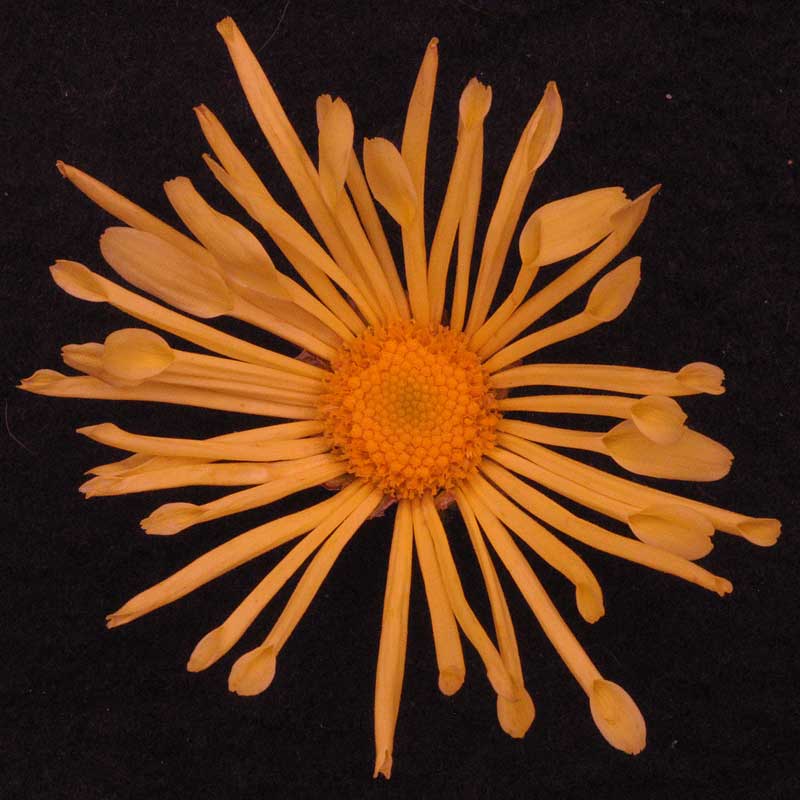

|
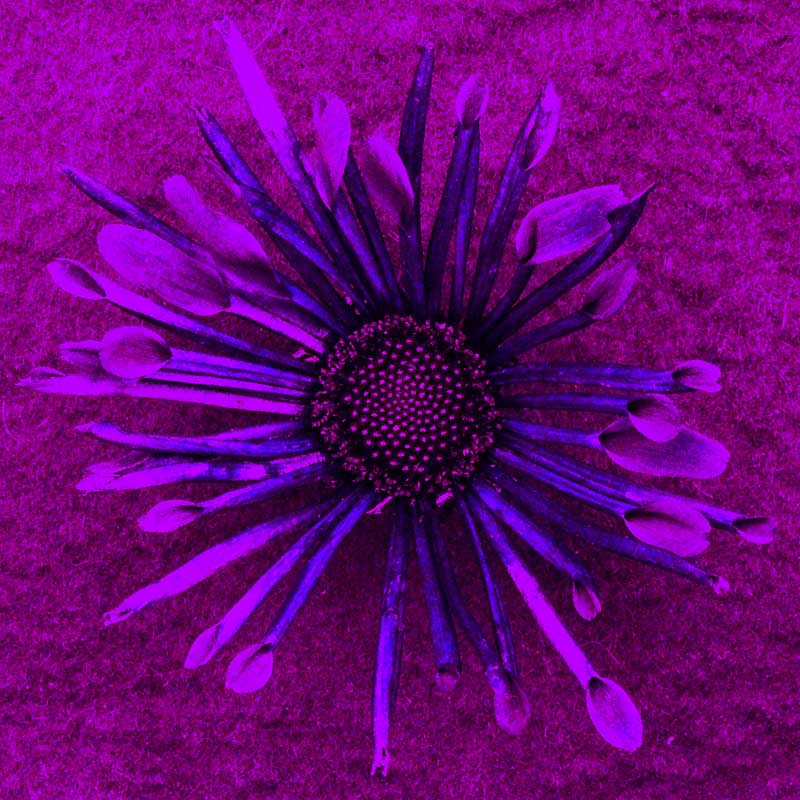

| |
| Coreopsis verticillata 'Zagreb' fills the blooming gap between Oenothera tetragona and Rudbeckia fulgida. Native bees love it; composite diameter 35 mm; 50% sun. |
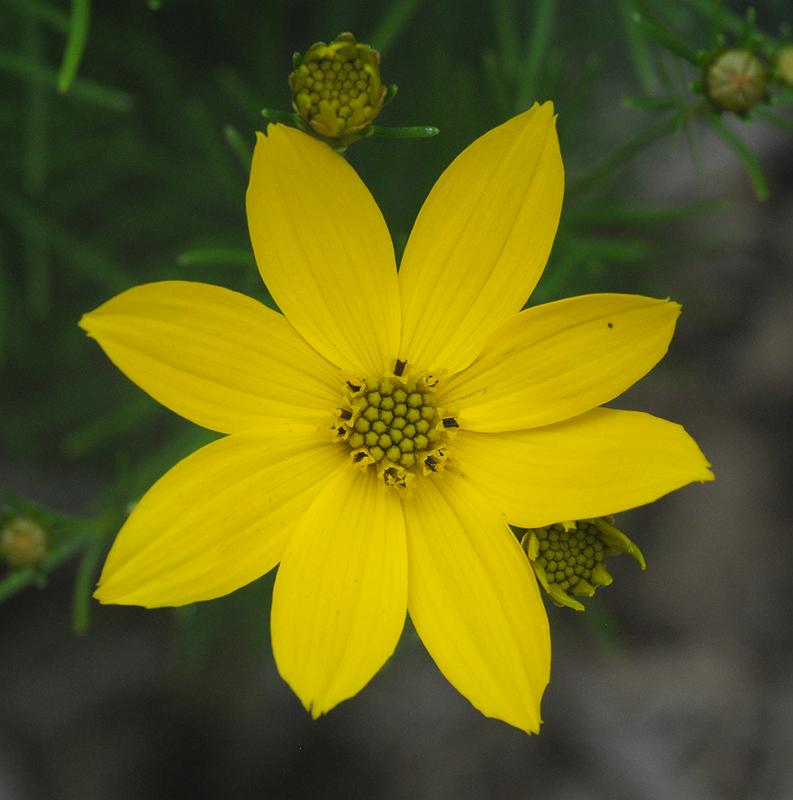

|
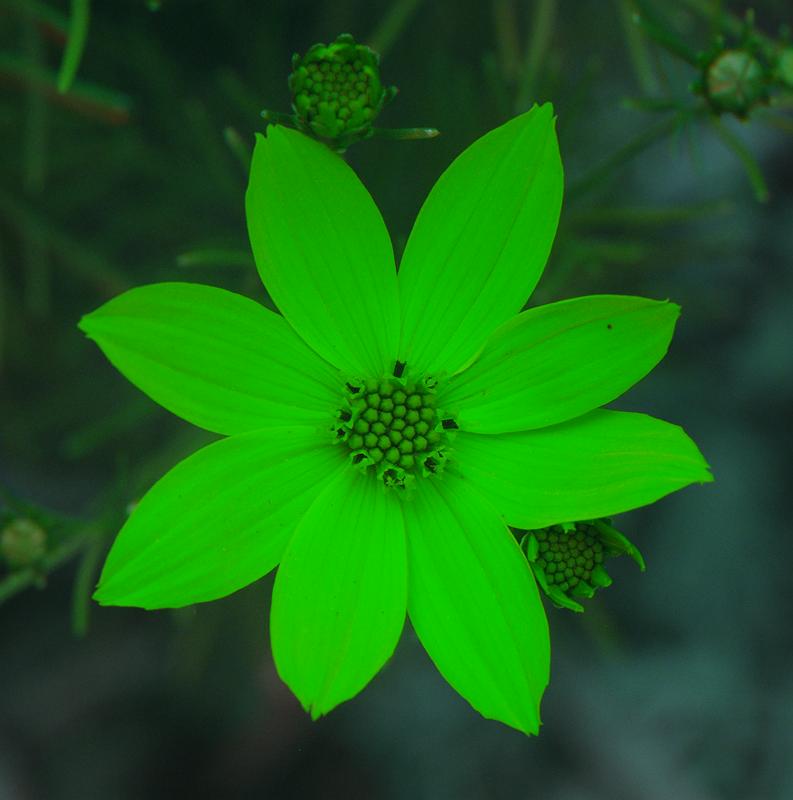

| |
| Crocus ancyrensis is native to calcareous mountain soils of Asian Turkey. In myth, the return of Persephone was signalled by the yellow crocus, this is one of the earliest here. The flowers are almost entirely black in ultraviolet; 60-80% sun. |
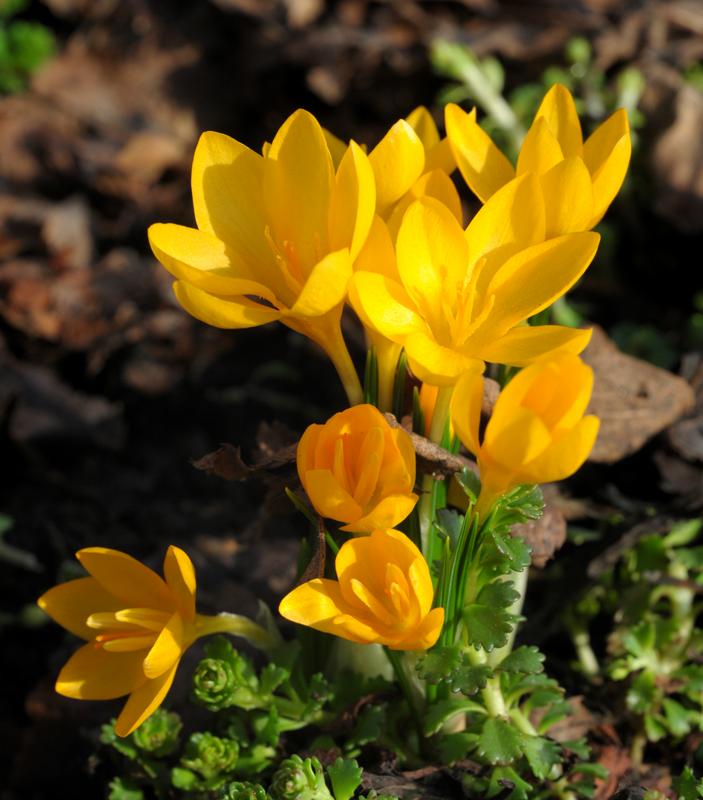

|
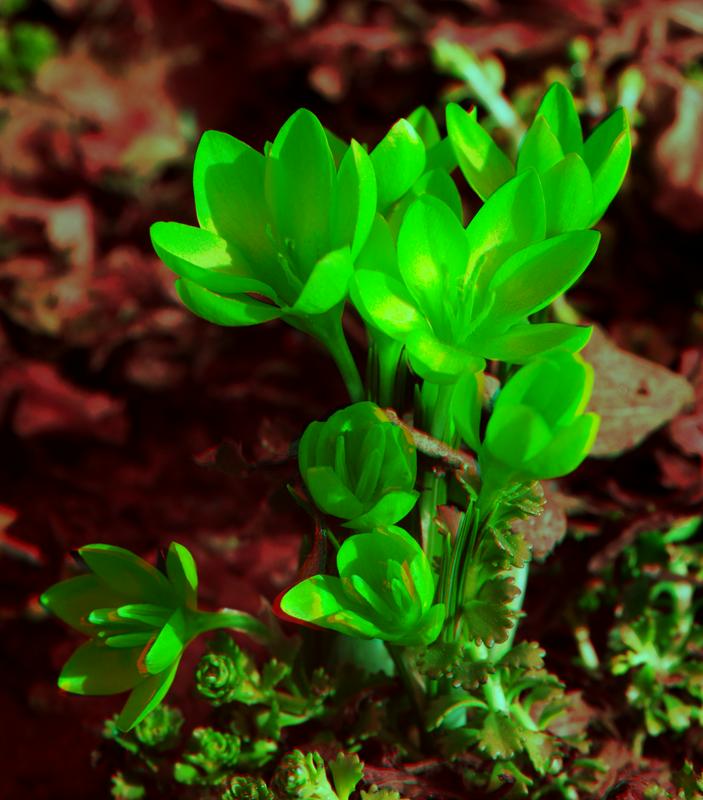

| |
| Crocus chrysanthus, native to calcareous open pine forests of the Balkans, was added fall 2010 to the front of the just-removed lawn; it's not doing as well as the C.ancyrensis. Some varieties (pallidus) are cream yellow in and out. In contrast to C.ancyrensis its stamens are bright white to insects; 60-80% sun. |
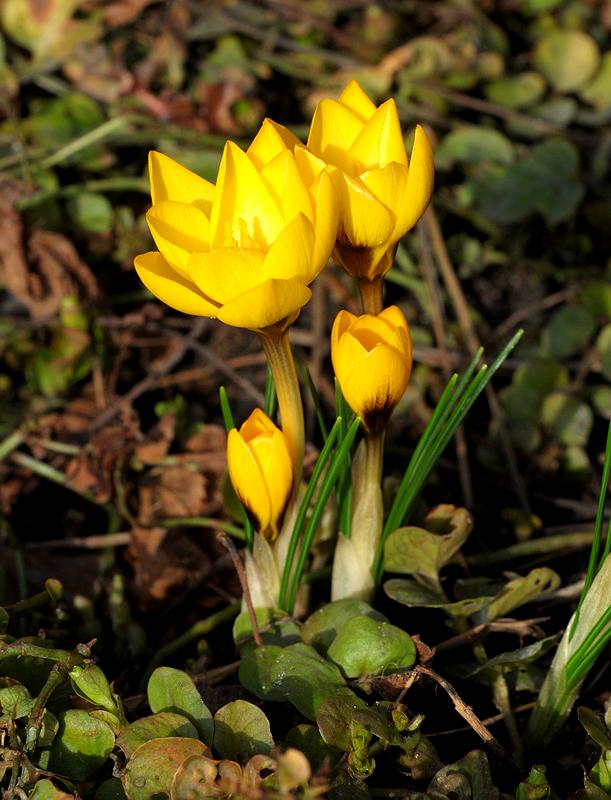

|
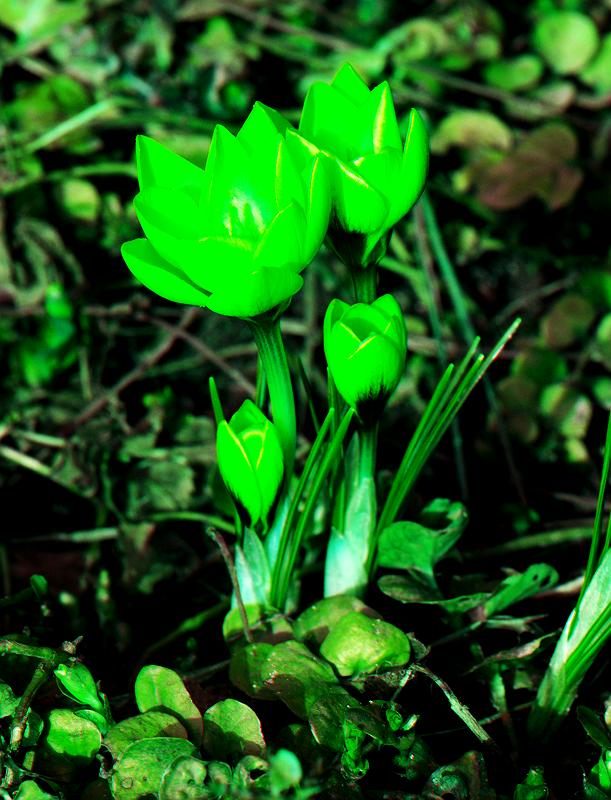

| |
| Crocus 'Yellow Mammoth' (angustifolius × flavus) produces a brilliant blast of yellow as well as copious offsets that are blooming size the next spring; 60-80% sun. |
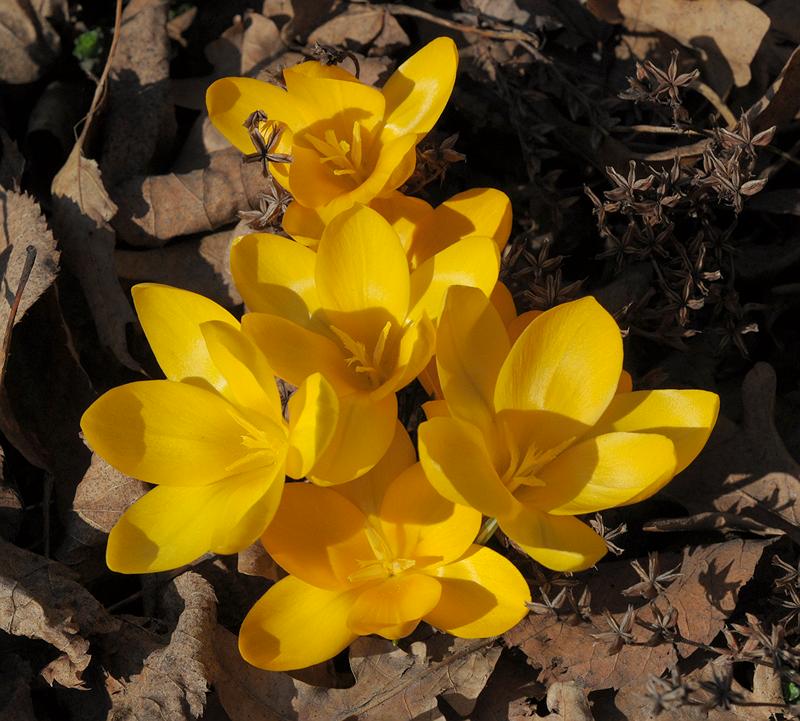

|
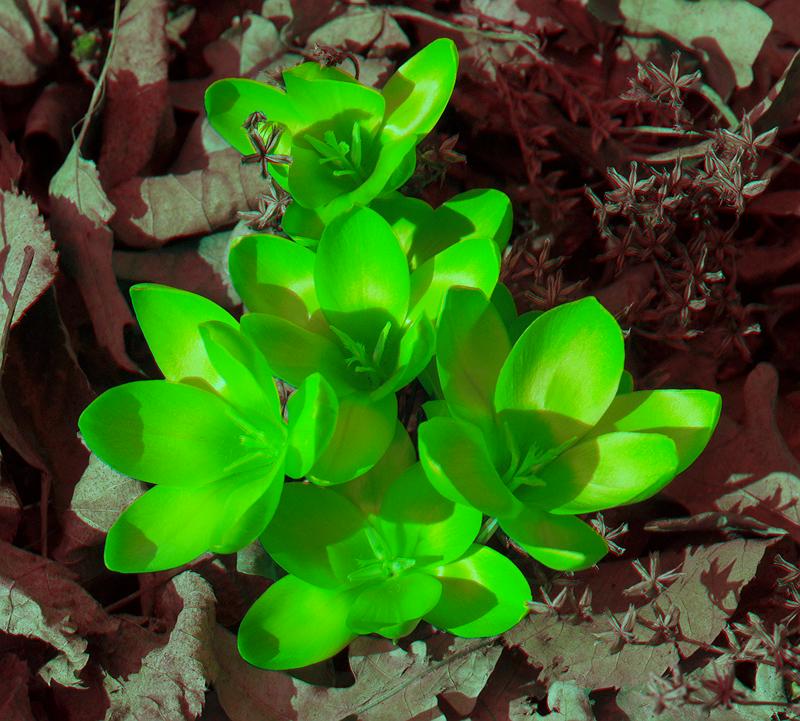

| |
| Doronicum caucasicum from Turkey needs mid-shade and moist soil, and puts on a nice show in spring just after Narcissus blooming time; composite diameter 40 mm; 20% sun. |
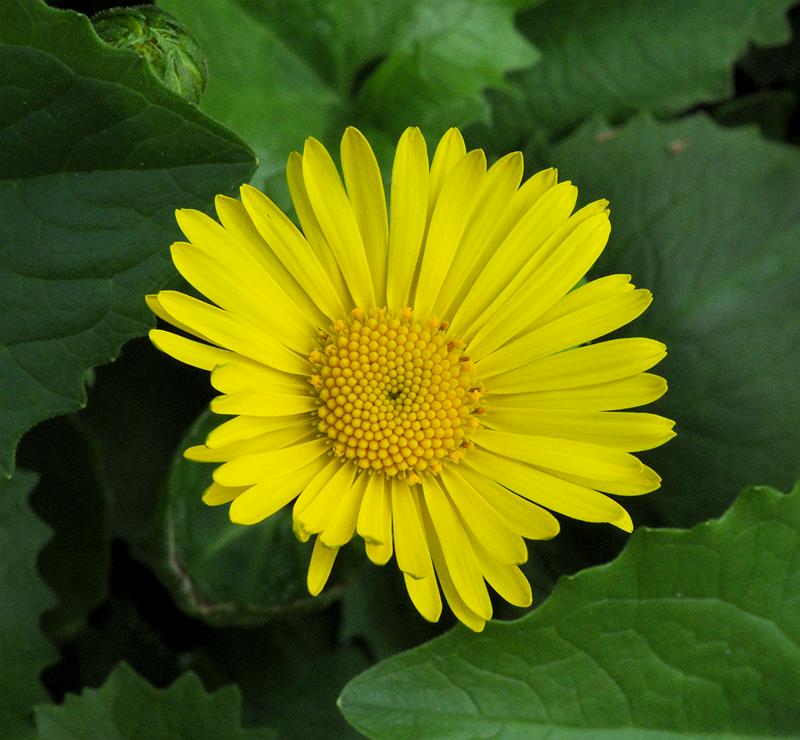

|
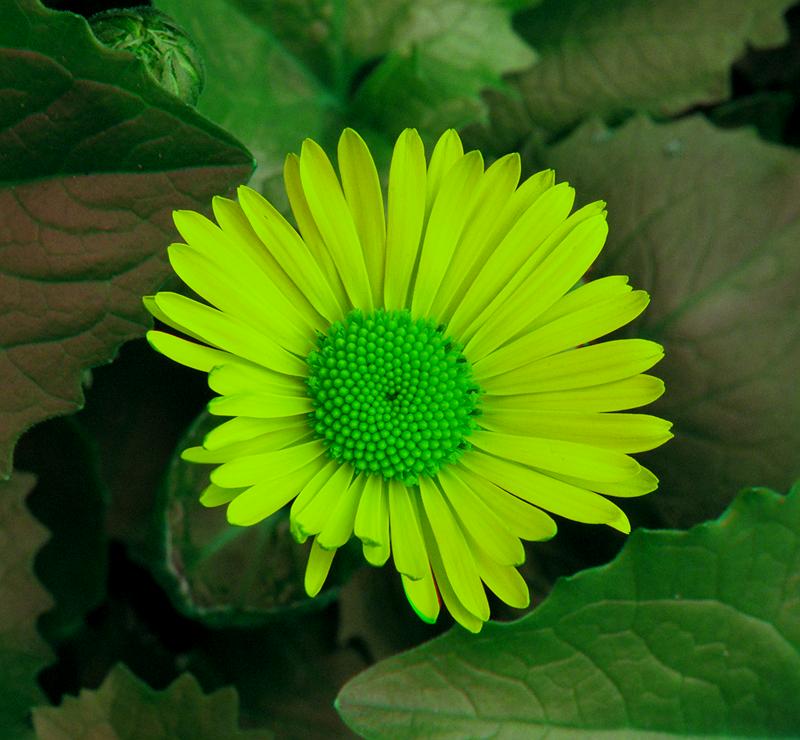

| |
| Epimedium ×versicolor (grandiflorum × pinnatum colchicum) needs mid to full shade, has leaves that stay green under the snow and delicate panicles of small sulphur-yellow flowers early spring. Low growing, it spreads slowly by rhizomes, and is doing well. Some say to cut back leaves in spring for best foliage, but I leave them - they make a good mulch for it; 15% sun. |
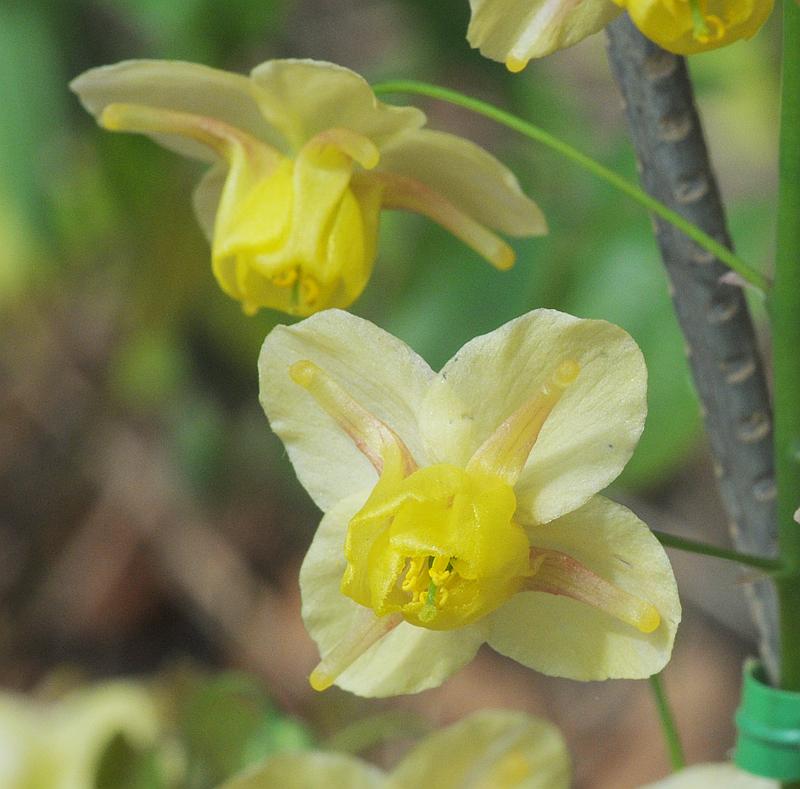

|
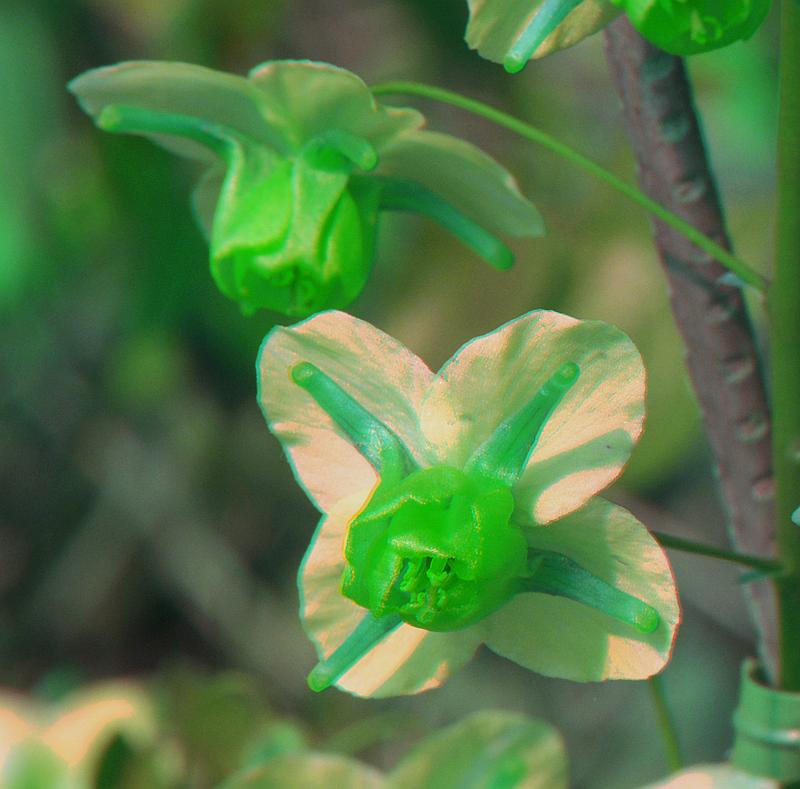

| |
| Eranthis hyemalis, native to Europe, needs sun. Two of ten bulbs have survived for several years now and are starting to produce offsets, but I rarely get more than one bloom per year; 75% sun. |
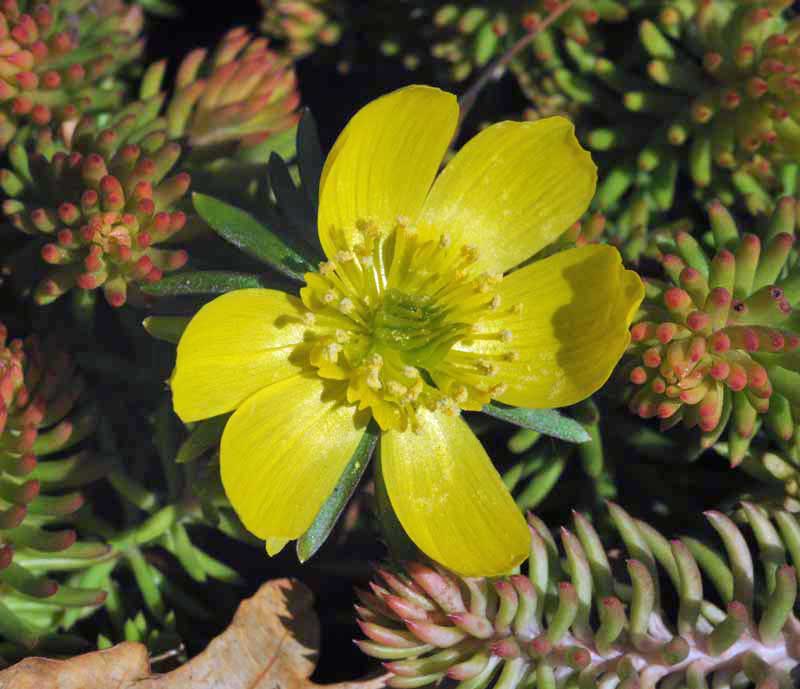

|
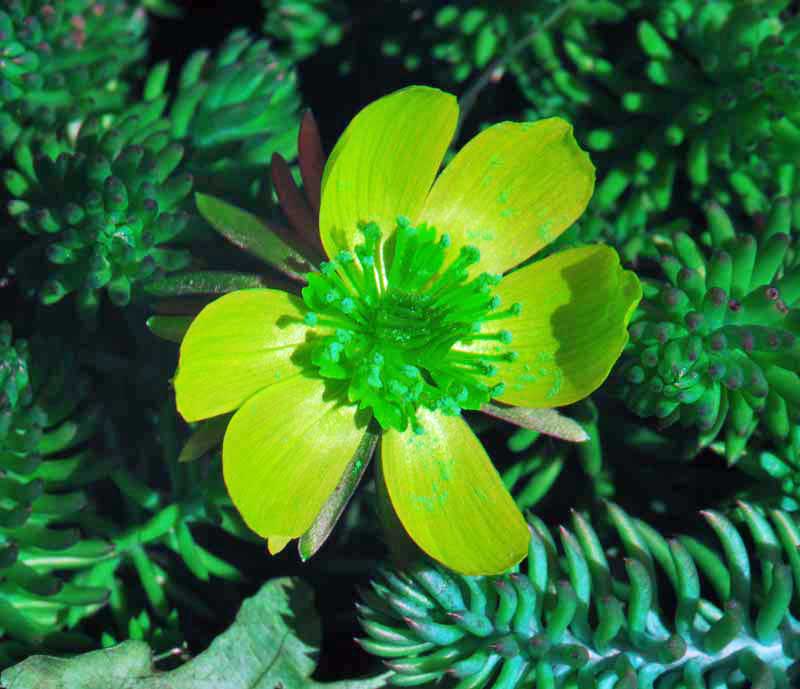

| |
| Hemerocallis line the west edge of the garden. From front to back:
Hemerocallis 'Winning Ways' is a spectacular clear yellow diploid with lots of blooms; Stout medal 1974; 150 mm diameter; 60% sun. |
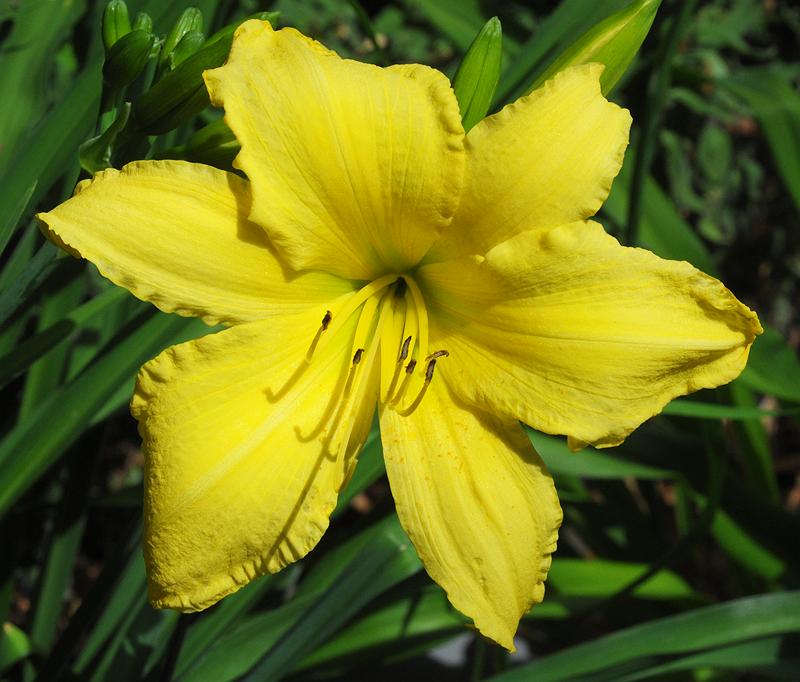

|
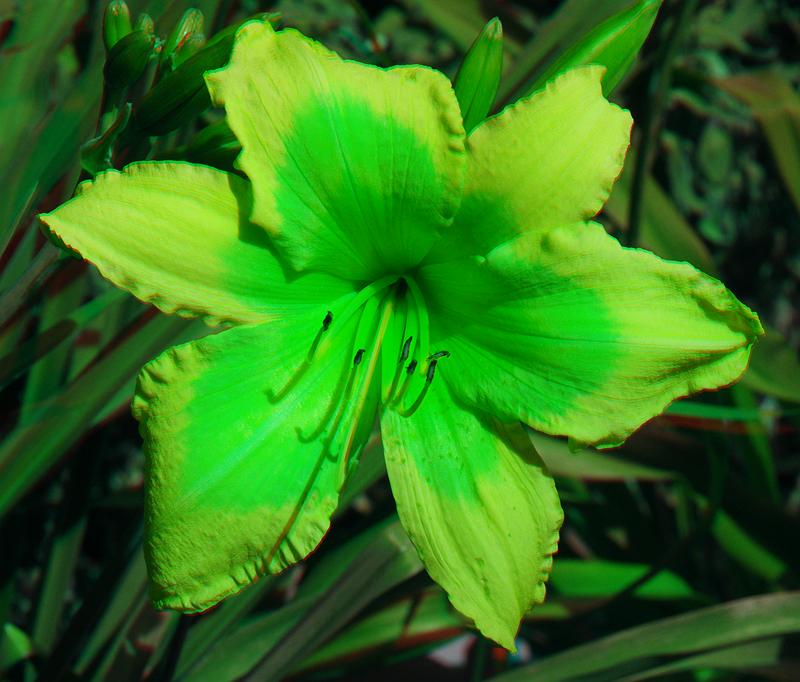

| |
| Hemerocallis 'Pudgie' is a semi-double added 2010, it's an intermittent bloomer; 90 mm diameter; 50% sun. |
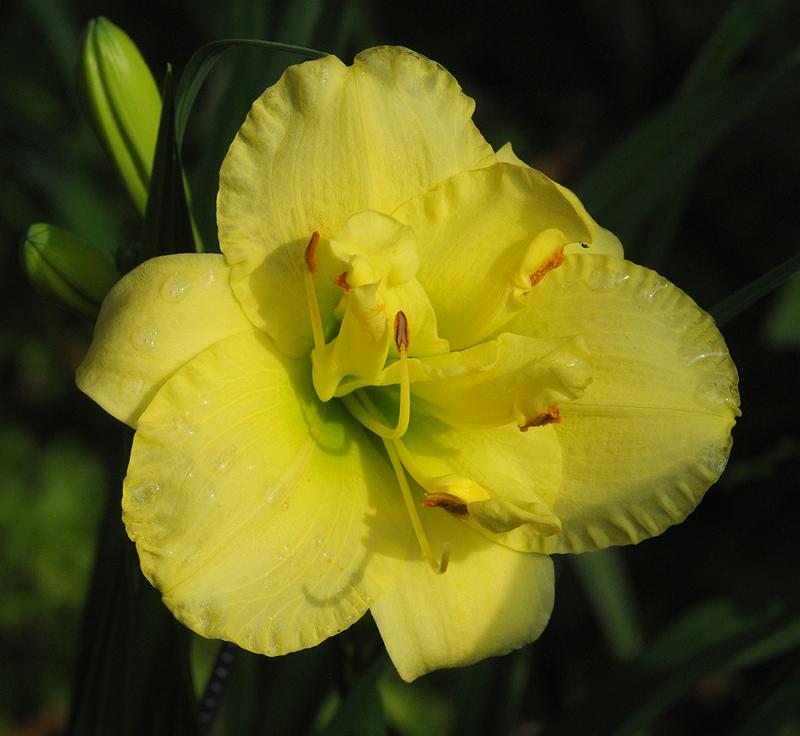

|
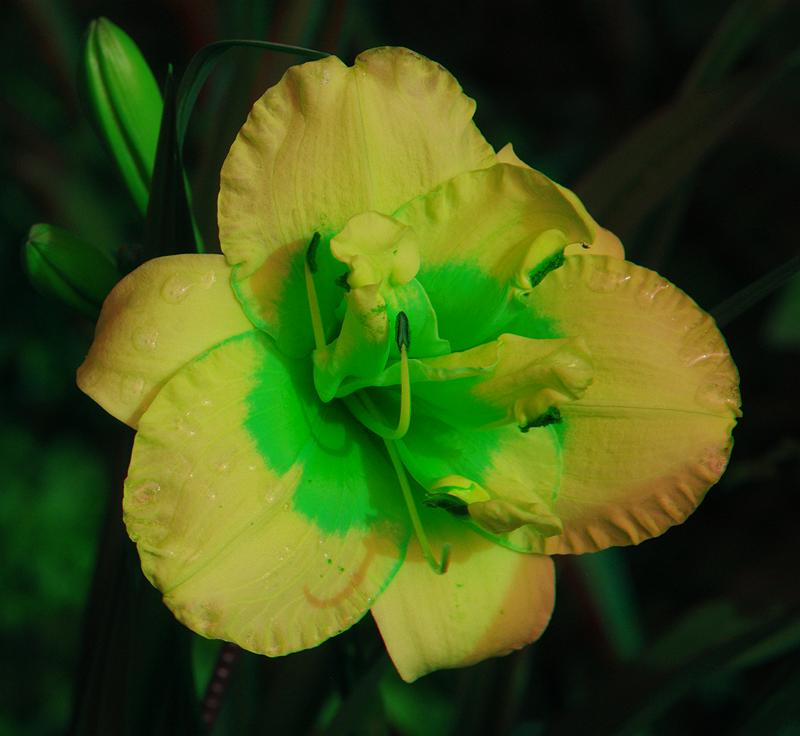

| |
| Hemerocallis 'Stella d'Oro' is a solid performer, blooms early and late summer, spreads, divides and transplants well, and blooms better in shade than any other I have. It's really orange, not yellow, so is slowly being replaced in the sunnier sections by offshoots from my favourite pure yellows; flower diameter 75 mm; 15-40% sun. |
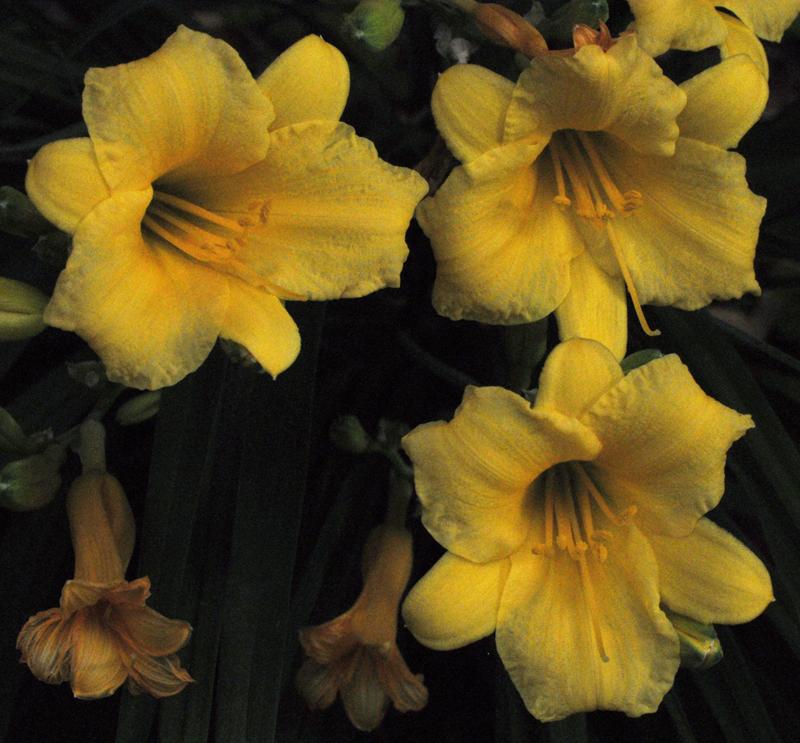

|
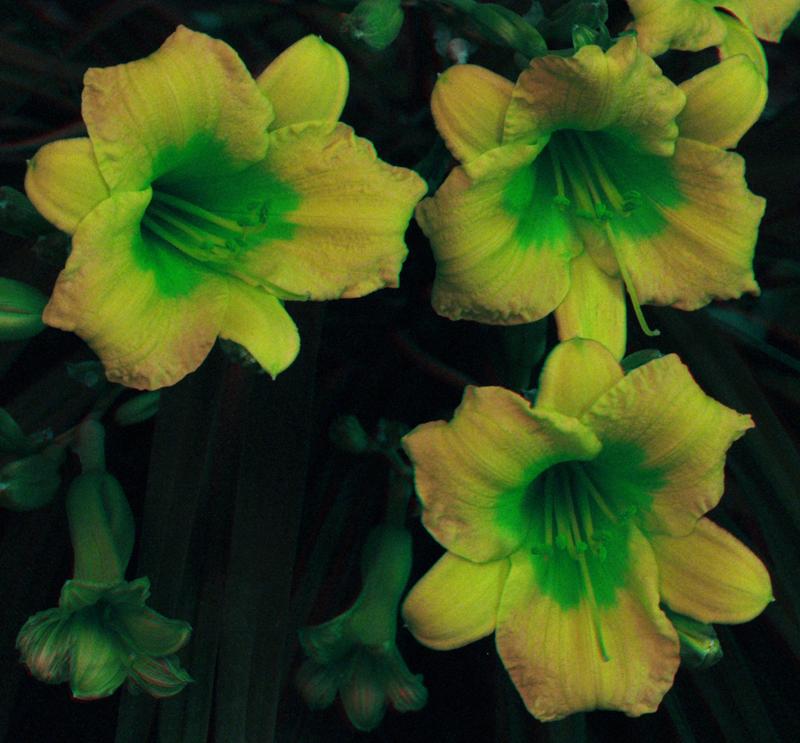

| |
| Inula ensifolia (Aster ensifolius), native to well-drained soils of eastern Europe, forms a tight clump that expands a few cm/year in every soil I've tried it in; 30 mm diameter; 20% sun. |
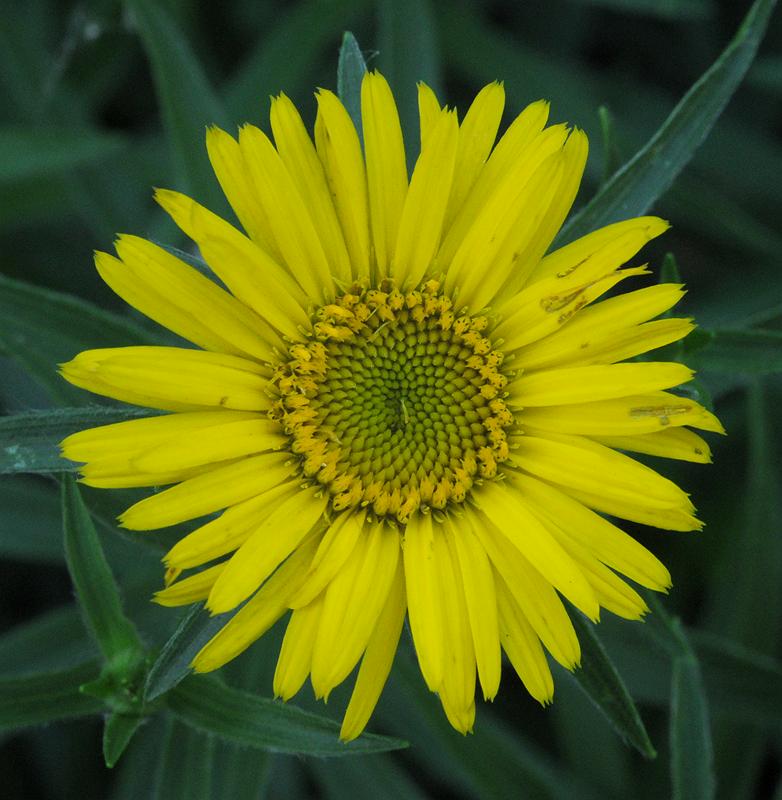

|
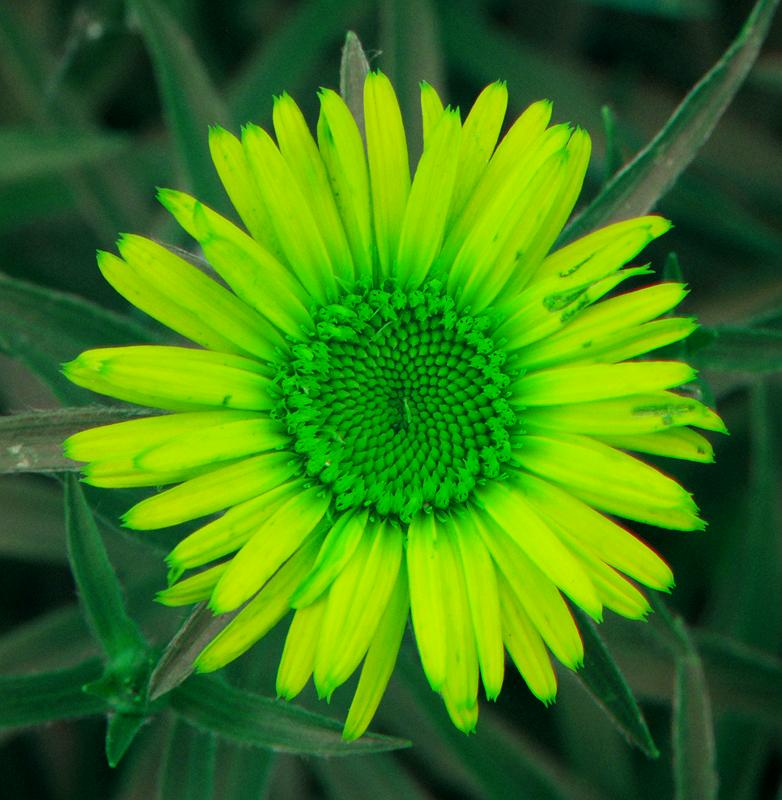

| |
| Lilium 'Tiny Bee', an early-blooming Asiatic designed by Mak Breeding for container growing, goes dormant some years; flower diameter 130 mm; 50% sun |
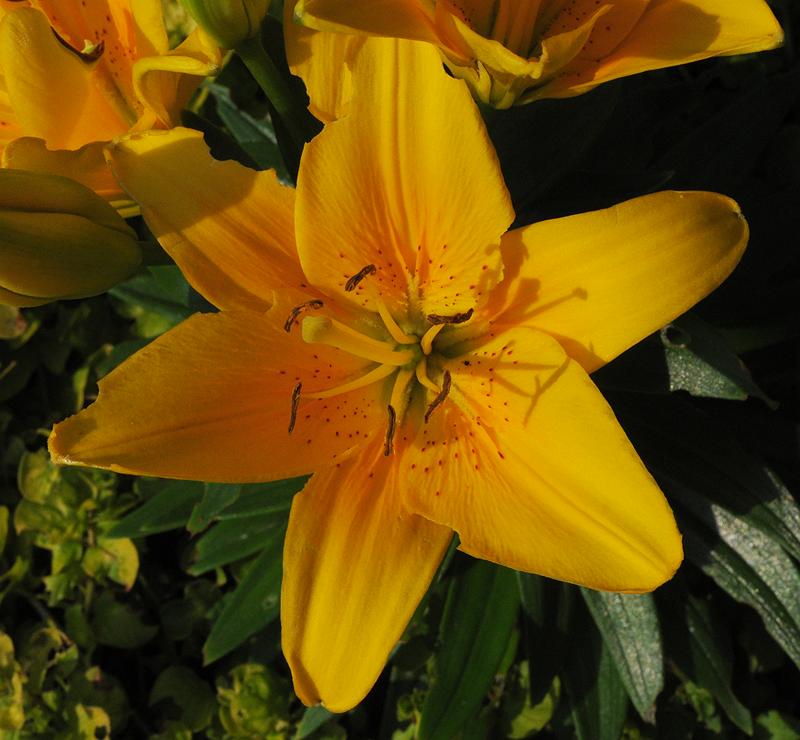

|
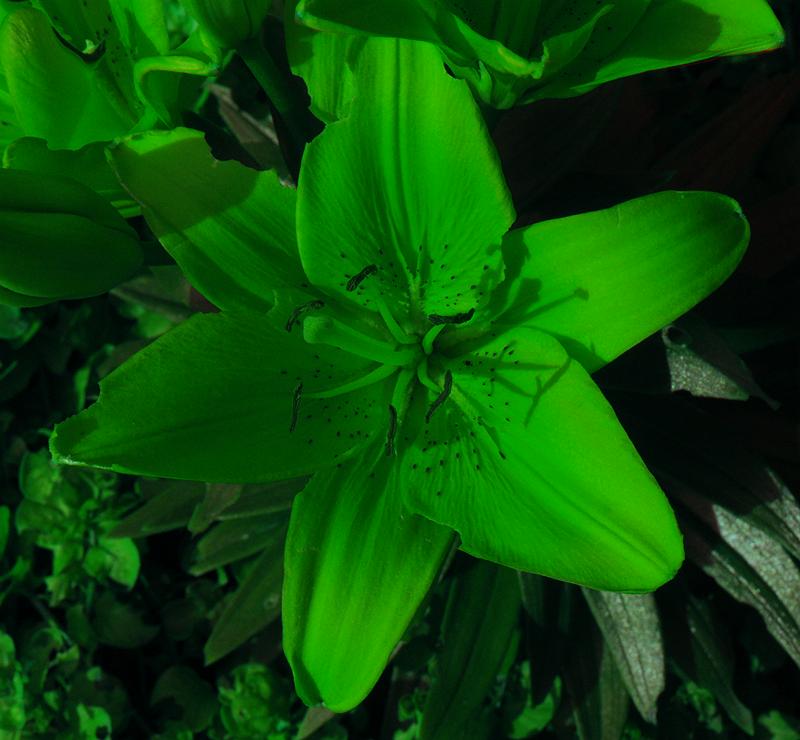

| |
| Lotus corniculatus is filling in the area next to the sidewalk that gets too much salt and snow plow abuse for sedum; flower size 10 mm; 80% sun. |
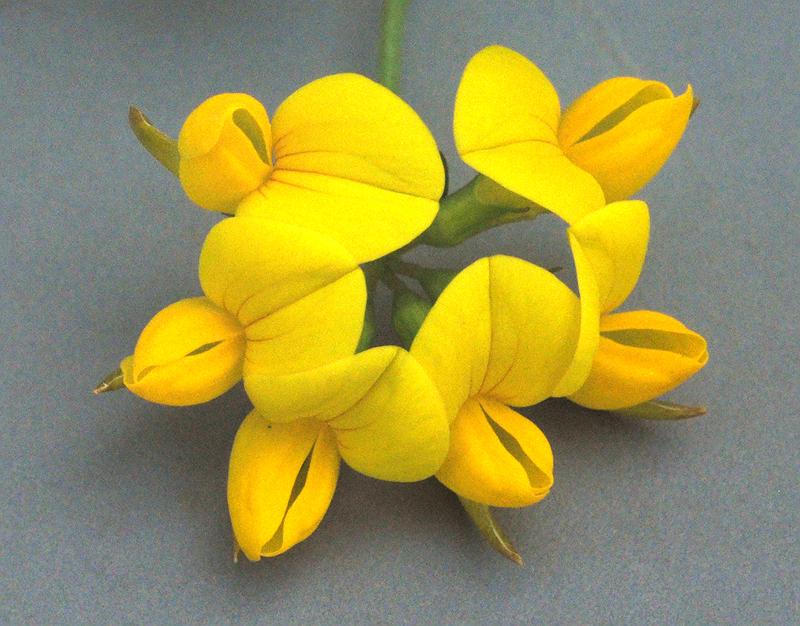

|
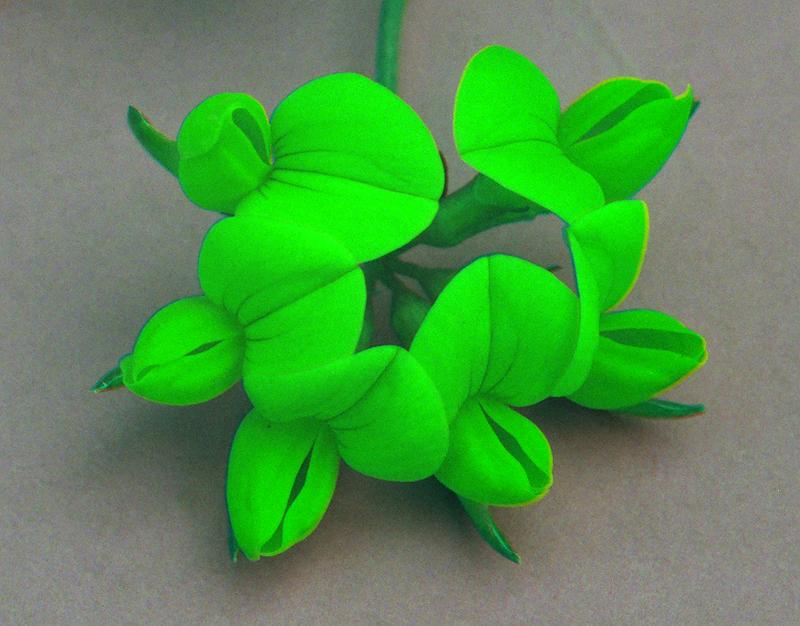

| |
| Lysimachia nummularia (L.zawadzkii) cultivar 'Aurea' from Europe needs mid to full shade. It's a 5 cm high golden-green ground cover with a few yellow flowers in mid summer where it gets 2 hours sun or more. It's spreading very well, looks great, allows established plants to grow through them unimpeded, is easily pulled up and trimmed where not wanted, and doesn't mind occasional gardeners' footsteps. My ground cover of choice for most of the garden; flower diameter 20 mm; 15-60% sun. |
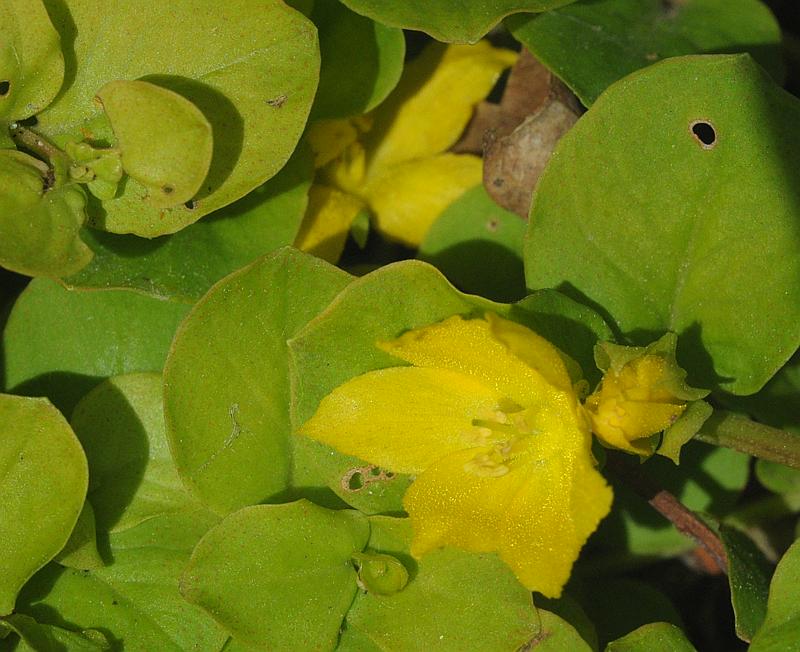

|
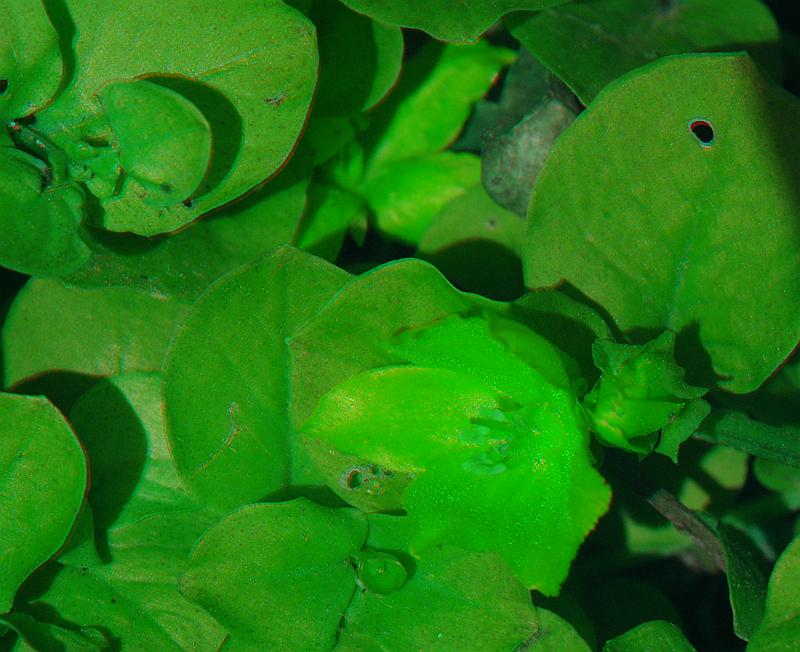

| |
| Lysimachia punctata, a North American native, grows best in mid-shade. It forms a tight slow-spreading clump with tall spikes that divides only with a sharp spade. A popular garden perennial a century ago, mine originally came from an overgrown old homestead site and has accompanied me for half a century now. One of my favourite plants; flower diameter 20 mm; 30% sun. |
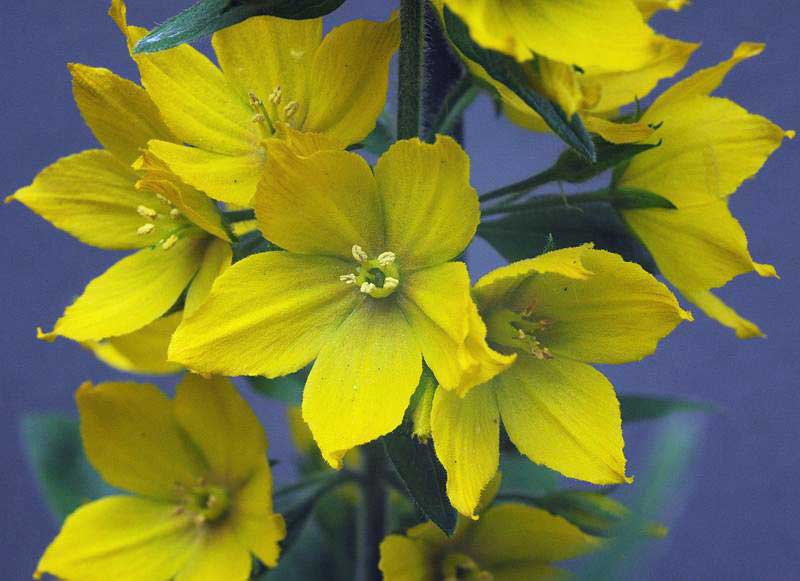

|


| |
| Narcissus are spread the width of the garden half way back in 40-60% sun. The bulbs are sufficiently toxic that squirrels don't touch them; the name comes from narce, narcotic. (The Greek god Narcissus was named after the trance he fell into while watching his reflection; the genus wasn't named after him.) | |||
| Narcissus 7Y-Y are multiflowered yellows - they bloom later than the 1Y-Y's I have; typical flower diameter 40 mm;. |
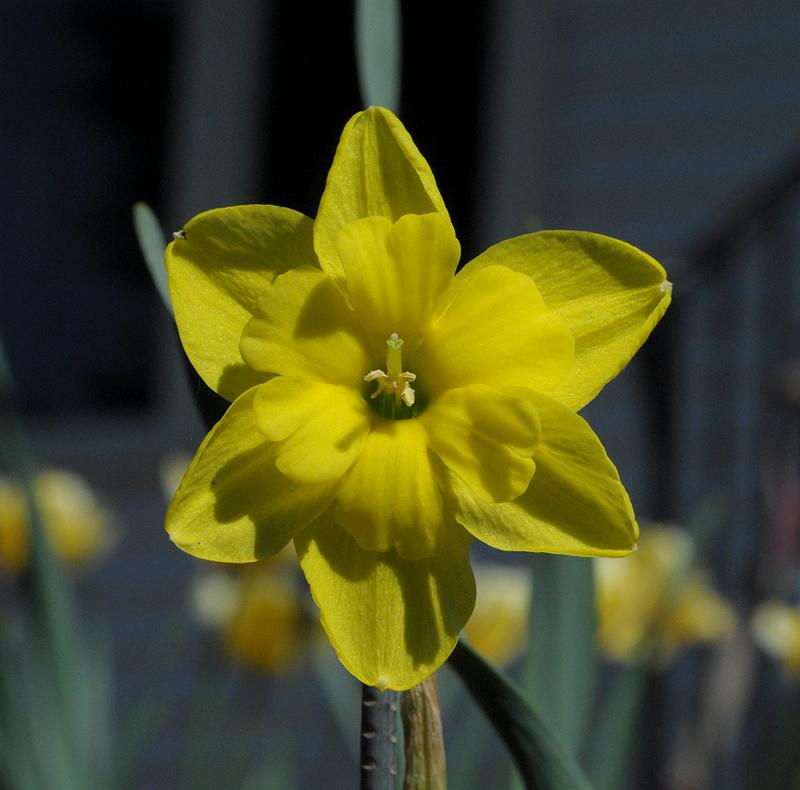

|
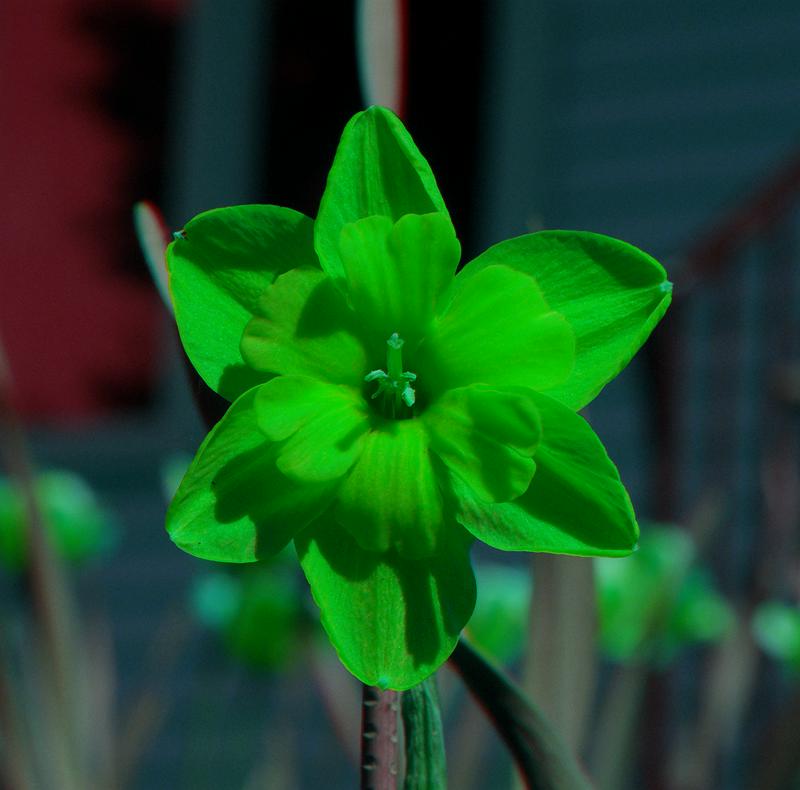

| |
| Narcissus 'Hawera' is a 5Y-Y miniature in a circle around the Amelanchier canadensis. |
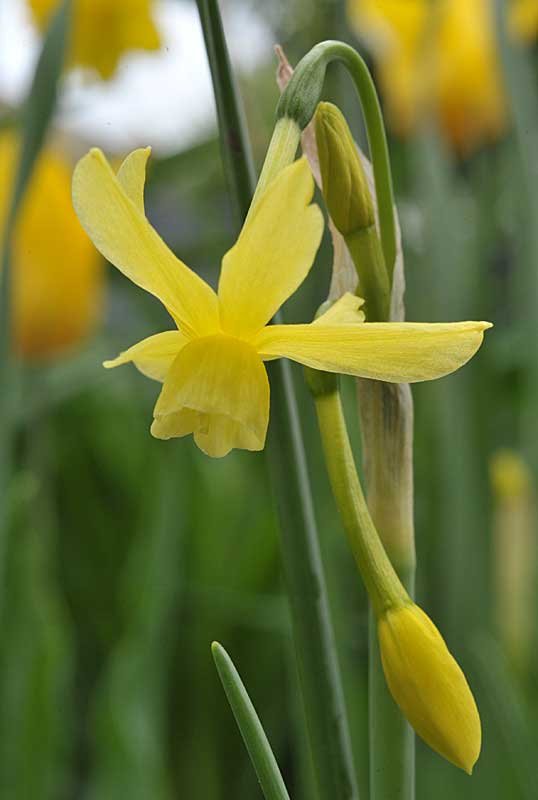

| ||
| Narcissus 'Sunny Side Up' 11aW-Y was moved from the back lawn fall 2009. I got one bulb in a mixture and tried to get some more, it looks so dramatic, but have never found it in Canada since, so I'm guarding its offsets - several dozen 2014. Photos on the web show perianth colours from white to yellow and varying degrees of corona ruffling, so it's probably a seed strain. |
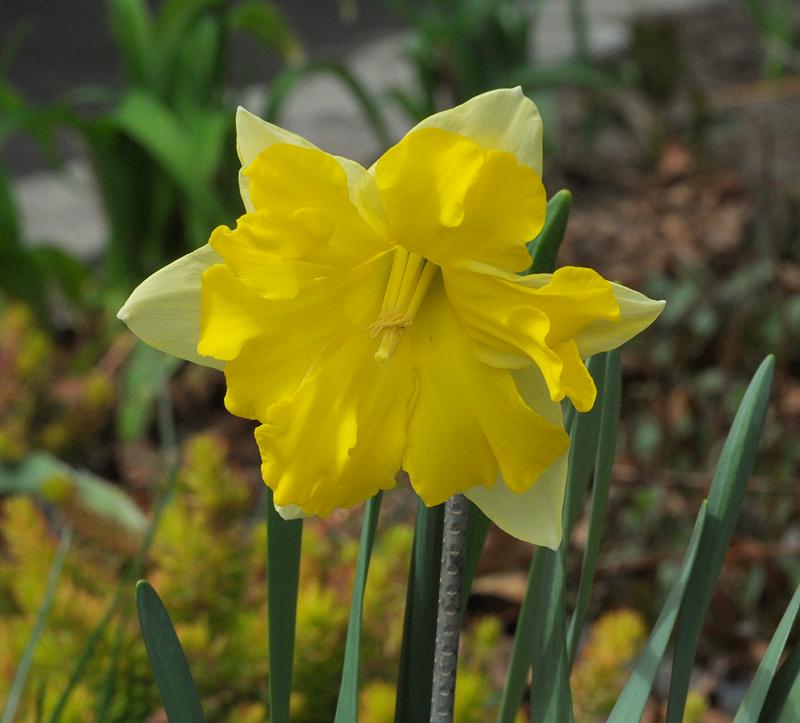

|
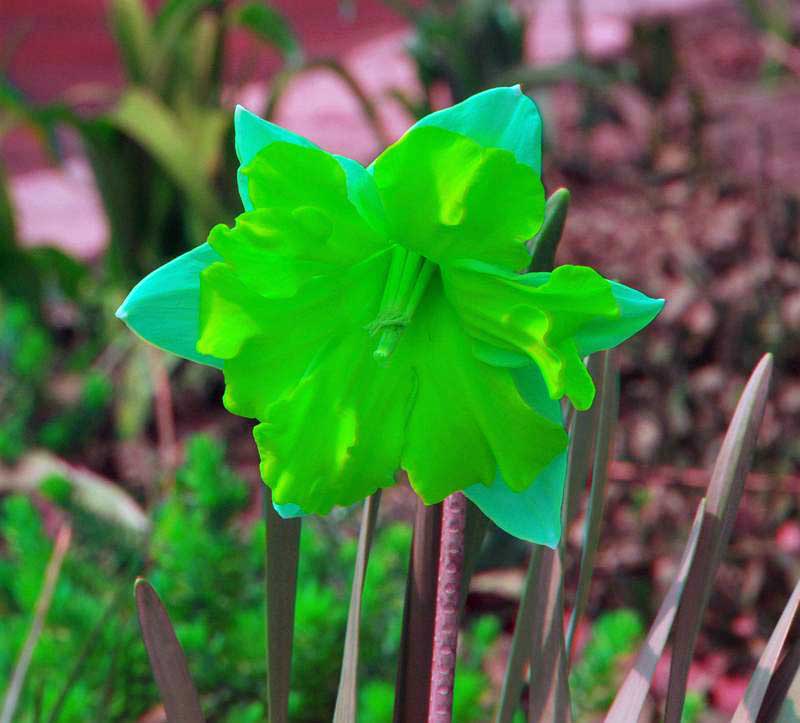

| |
| Oenothera tetragona (O.fruiticosa...), a variable North American native originally described under at least 6 names now considered subspecies or synonyms, has lots of brilliant yellow terminal flowers. It spreads fairly fast by stolons, so is best contained by edging. It flopped in 20% sun, was moved to 60% sun late 2008 and has put on a superb show since. |
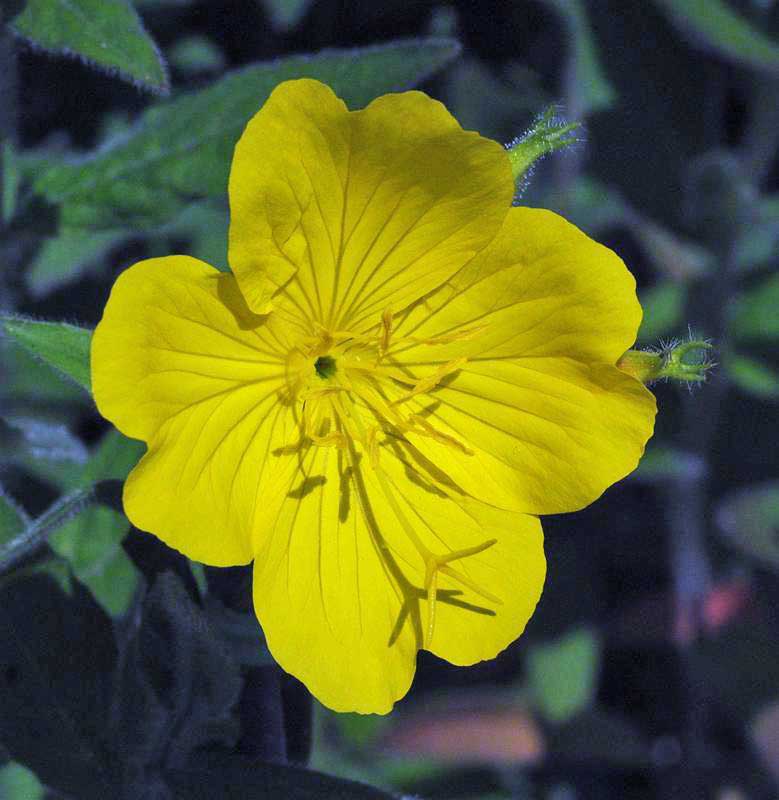

|
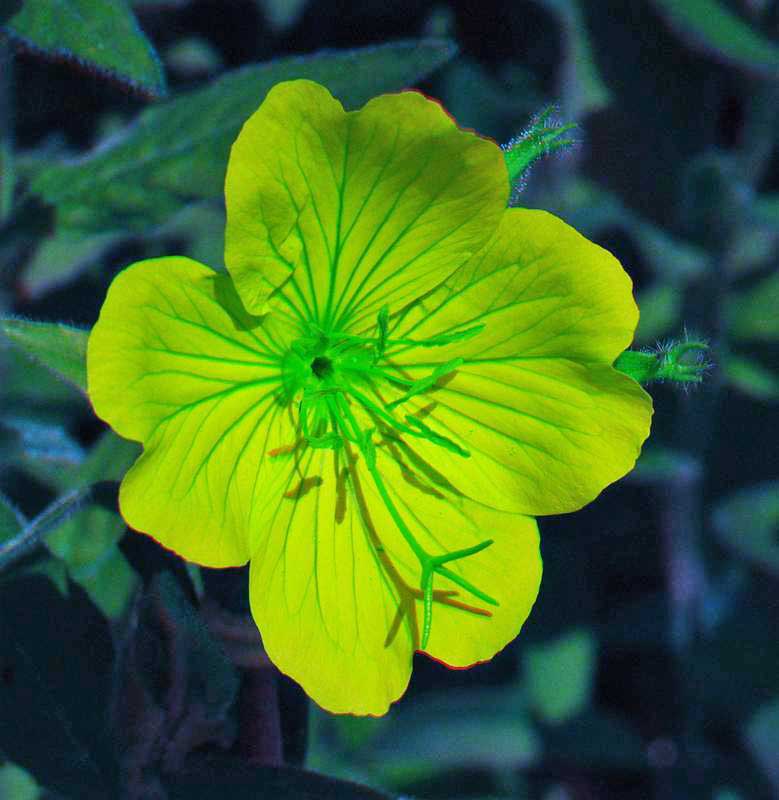

| |
| Primula algida from northern Asia bears smallish flowers in long-stemmed umbels; it's growing and flowering well but its blooms flop in a circle; 30% sun. |
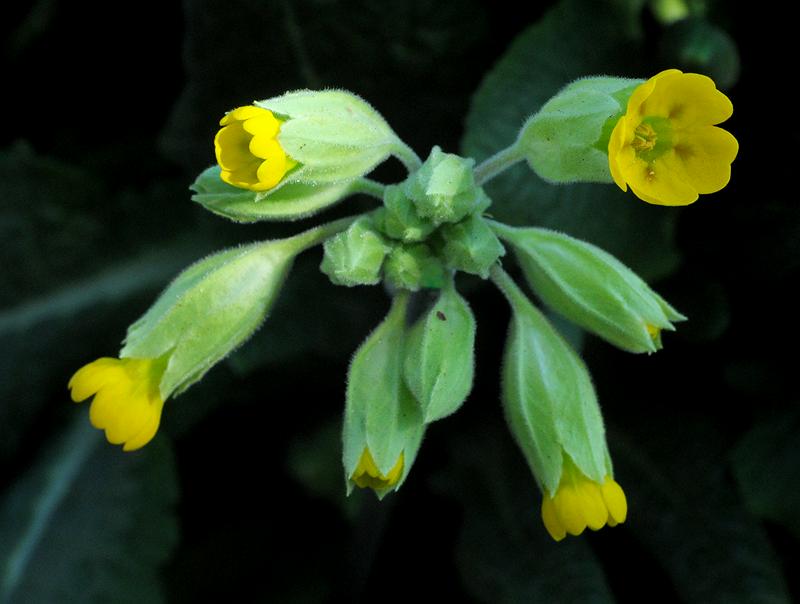

|
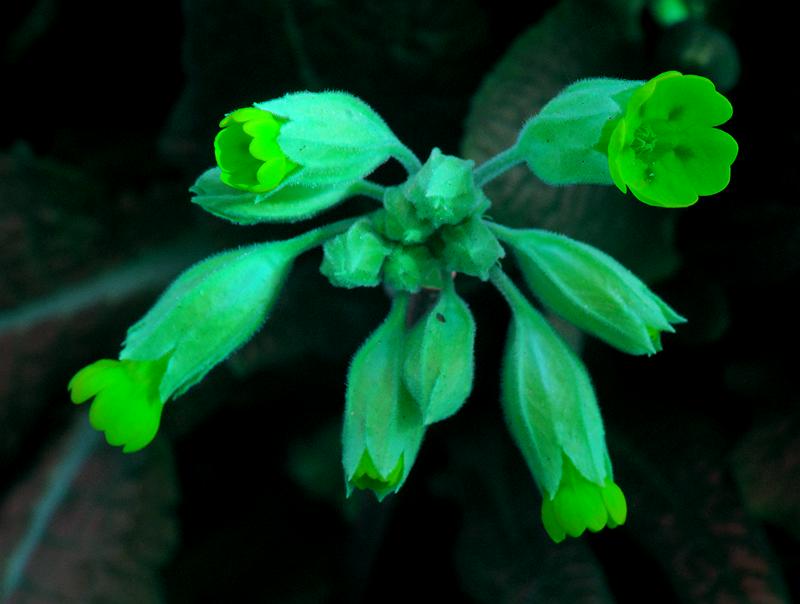

| |
| Primula elatior from the Caucasus bears its flowers in umbels above the leaves and
is growing and blooming well; 30% sun.
Primula veris from Europe is identical to P.elatior except for technical differences in the corolla throat and leaf petiole, and is also growing and blooming well; flower diameter 10 mm; 30% sun. |
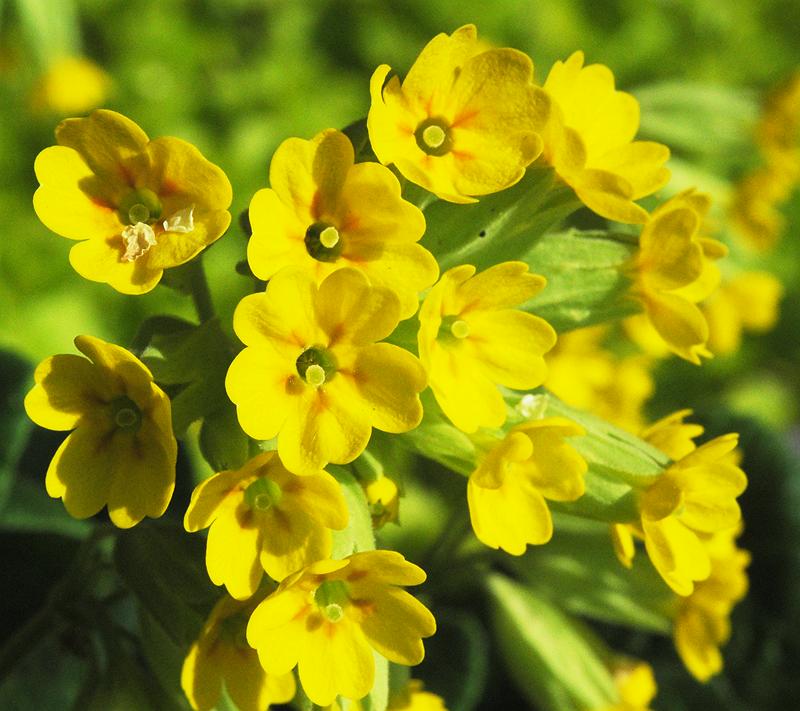

|
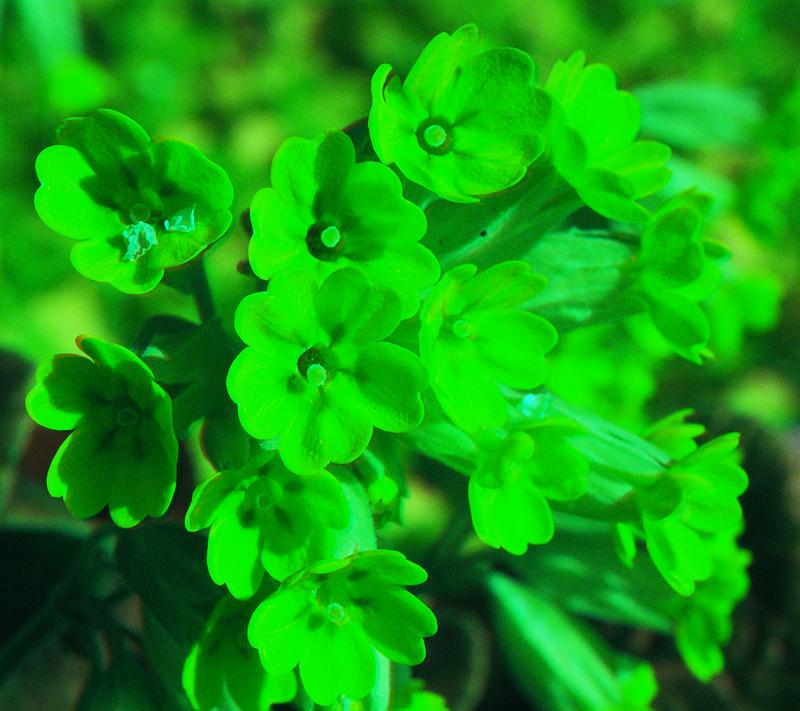

| |
| Primula polyantha may be a natural hybrid of P.elatior, its blooms are open and strong; flower diameter 22 mm; 40% sun. |


|
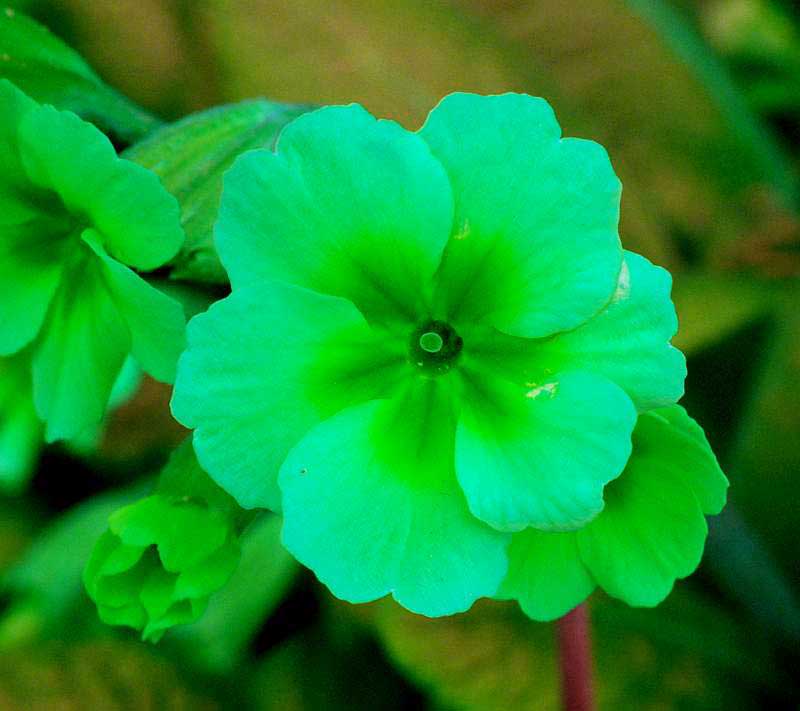

| |
| Ranunculus ficaria is from Europe and east Asia, it forms a tight slowly-expanding clump that's covered in blooms mid-spring; 15% sun but I think it prefers more. |
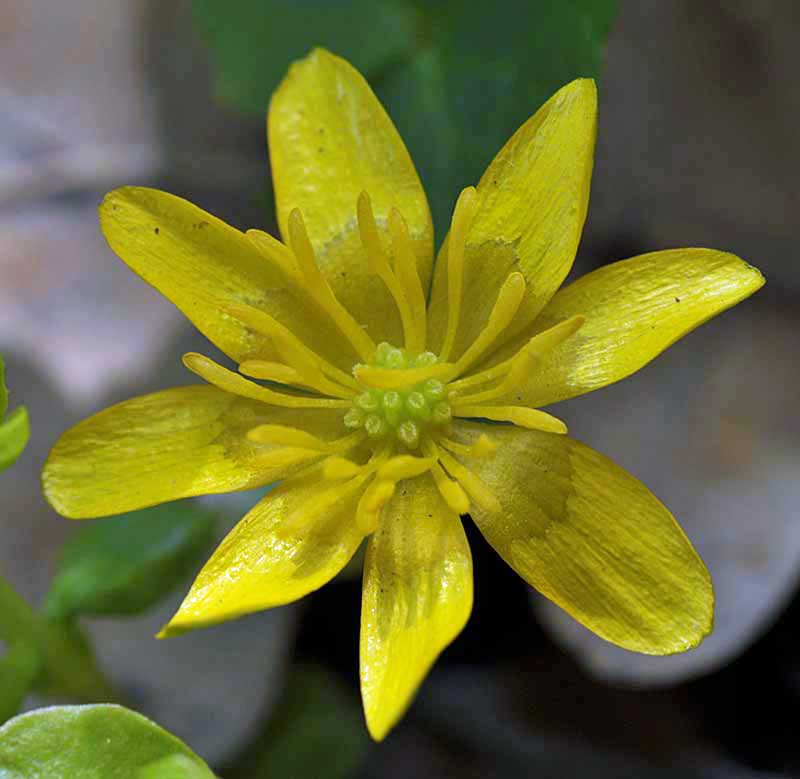

| ||
| Rudbeckia fulgida, a North American native, prefers consistently moist soil and mid-shade. It produces a great show of summer and fall yellow, divides and transplants well; 30% sun. |
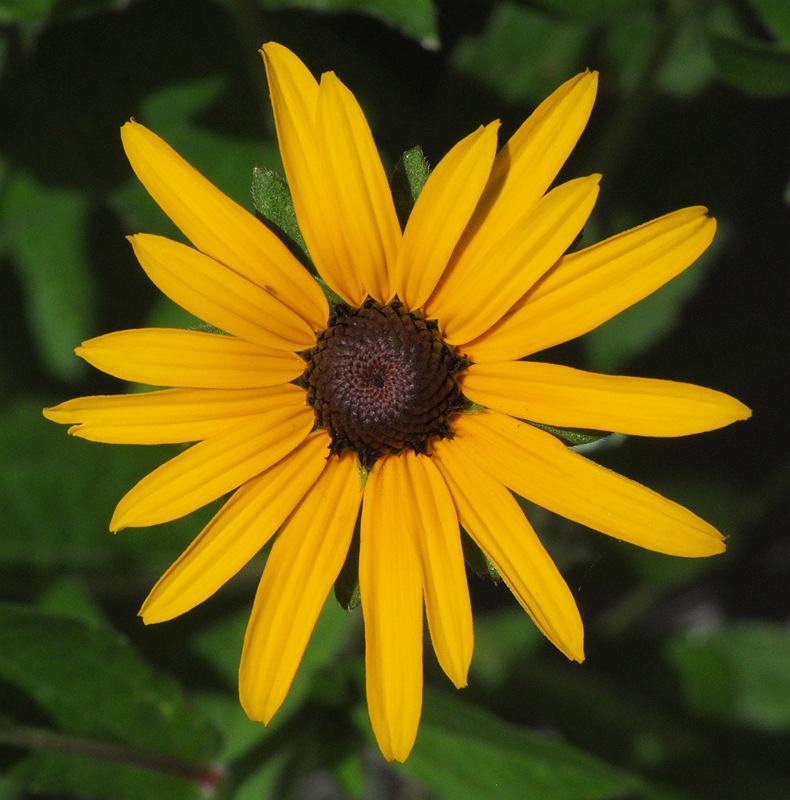

|
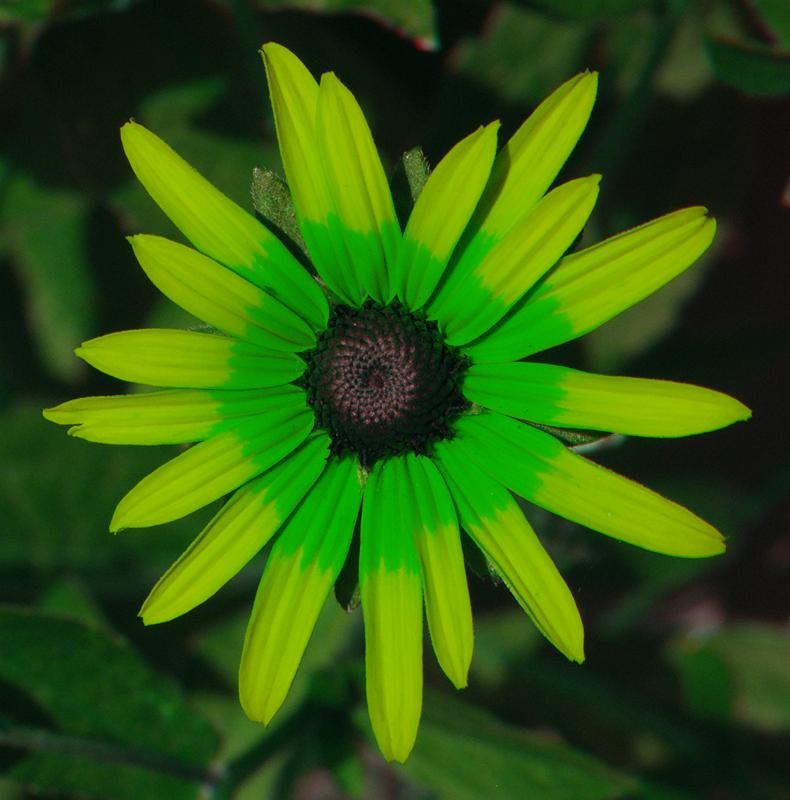

| |
| Sedum kamtschaticum (Phedimus kamtschaticus) from northern Asia begins blooming late May and keeps blooming until completely covered by snow. Most sedum prefer dry full sun, but this one grows well with as little as 20% sun and is happy with damp soil. It suppresses seed-borne weeds well but stolon-grasses have to be removed promptly to avoid infestation; flower diameter 14 mm; 40-80% sun. |
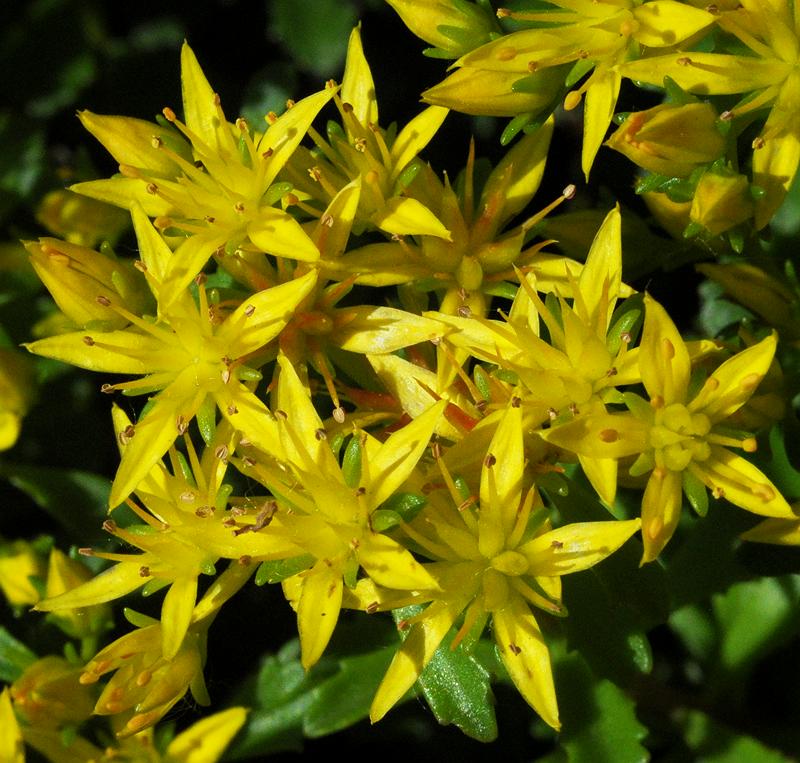

|
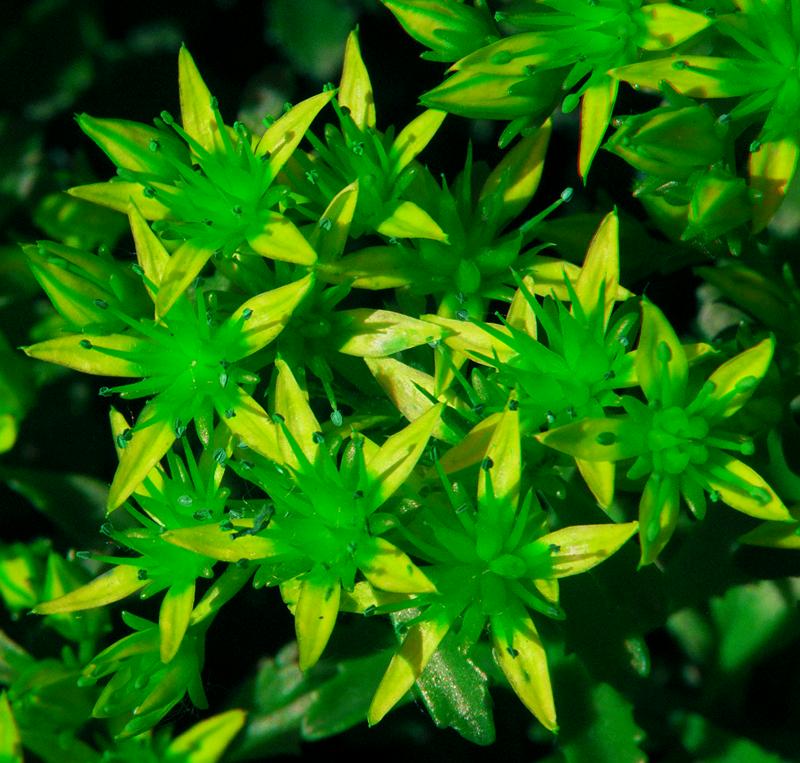

| |
| Sedum rupestre (S.reflexum, Petrosedum rupestre), native to central and western Europe, covers the bright corner at the front as a ground cover for small bulbs. It blooms only briefly and the blooms are almost invisible against the leaves, but it provides a yellow background throughout the year with a texture that contrasts nicely with the Lysimachia, which does the same. It doesn't resist weeds as well as S.kamtschaticum; 70% sun. |
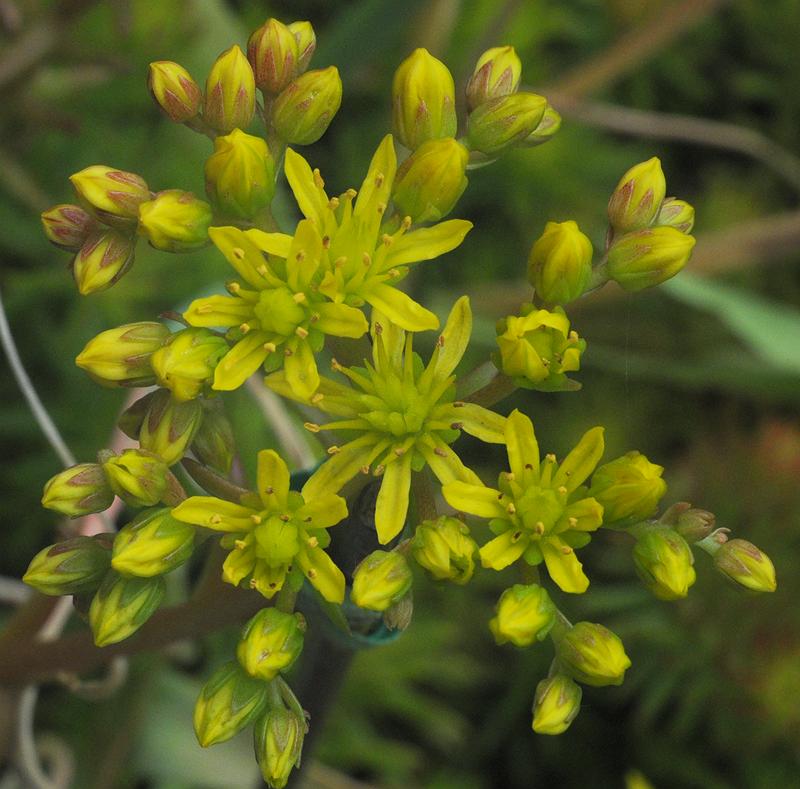

|
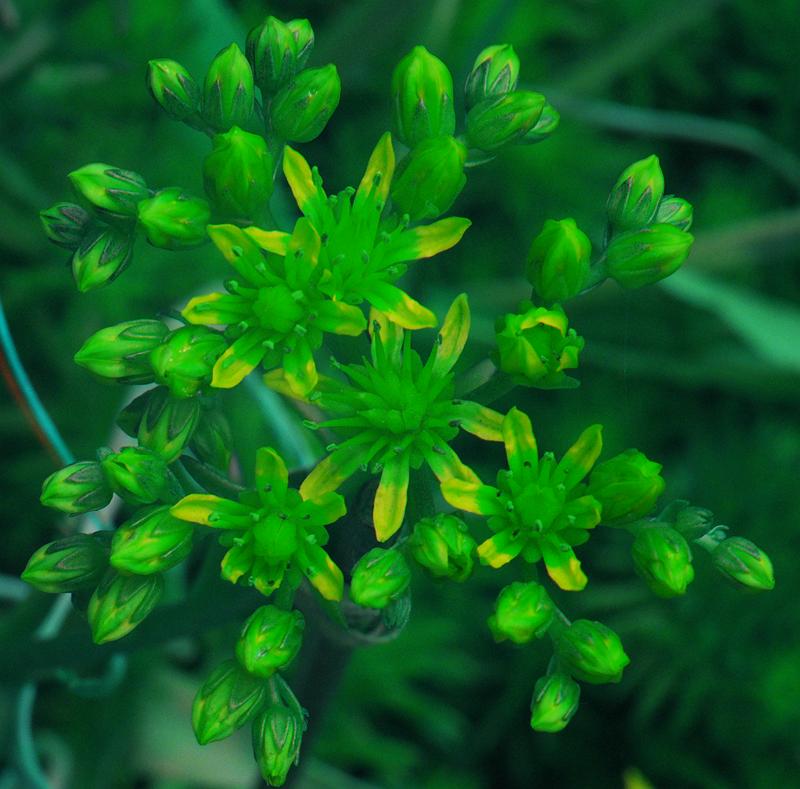

| |
| Solidago rugosa is a magnificent backdrop to the garden. And, it attracts more pollinating insects than any other plant I have. |


|
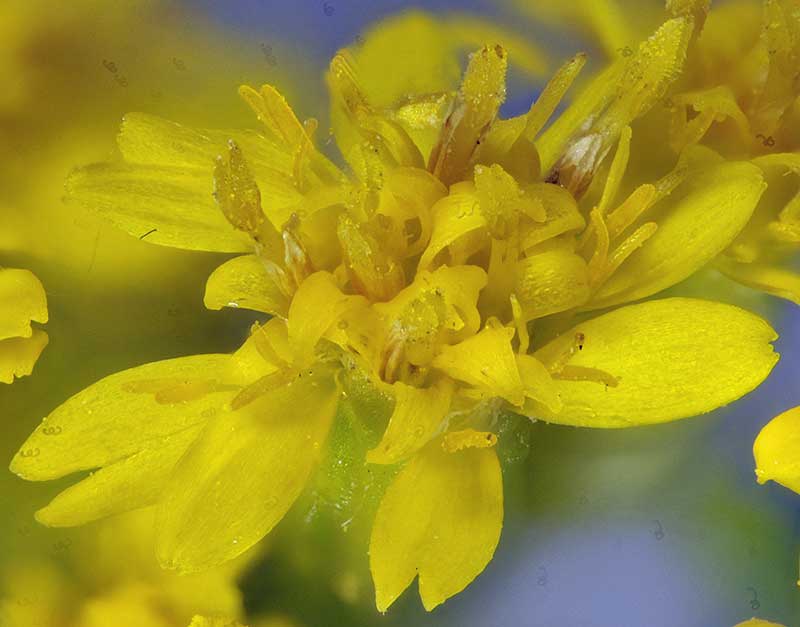

| |
| Trillium luteum emerged every spring for a decade without blooming, but 2021 saw its first yellow. 30% sun when it is up (before being shaded by a Prunus virginiana). |
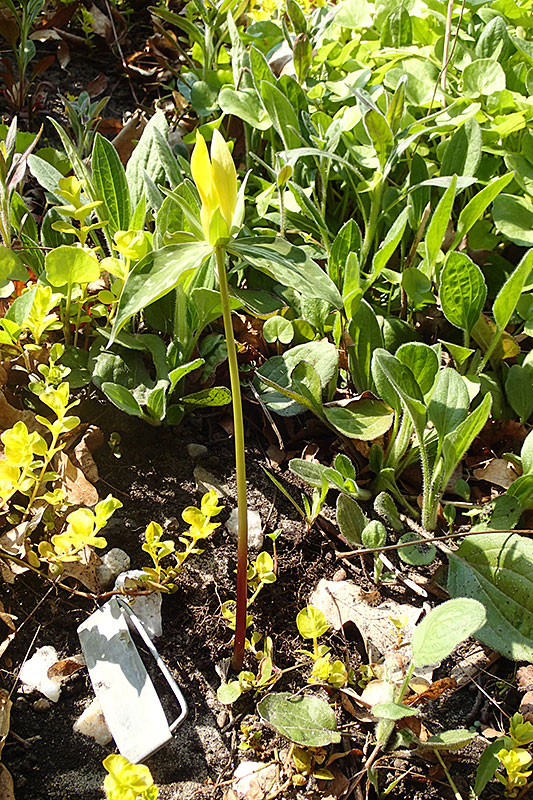

| ||
| Tulipa species are along the front of the raised portion. Their commercial cultivation began in the Ottoman Empire, they were introduced to Europe from Turkey in 1554; squirrels and chipmunks love them so they last only if protected by ground covers or cocoa bean mulch; 60% sun. | |||
| Tulipa dasystemon (T.tarda) from Kazakhstan has several blooms per bulb, produces offsets sufficient to resist predation and is happy in mid-shade. |
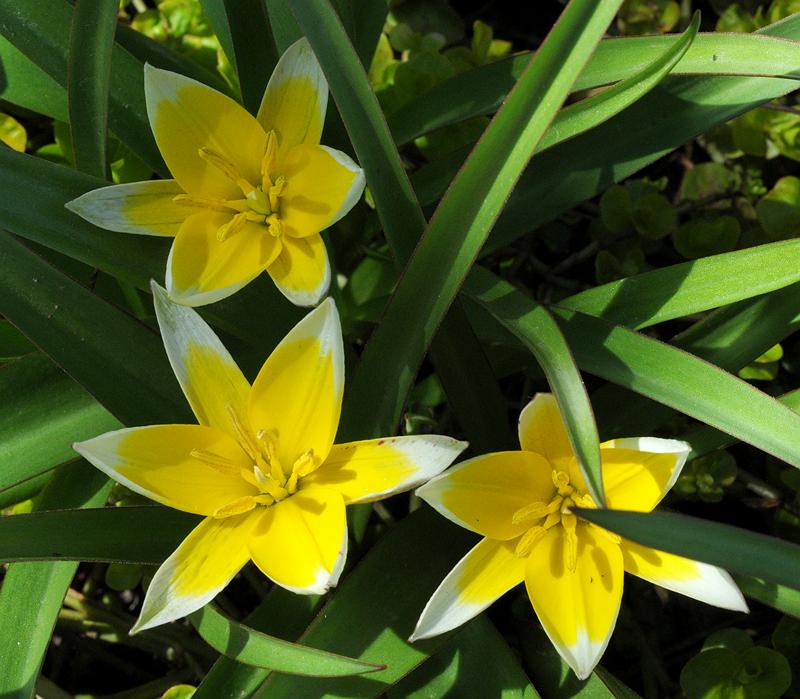

|
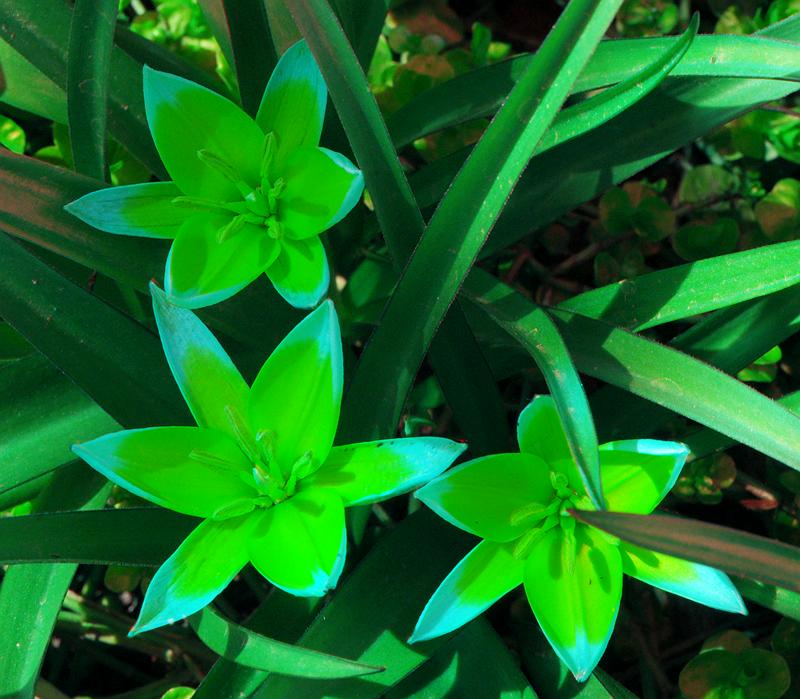

| |
| Tulipa turkestanica is indeed from Turkestan, its colour varies from almost all white to all yellow, but it's barely surviving here. It's blooms close at night to preserve them for warm sun when pollinating insects are most active. |
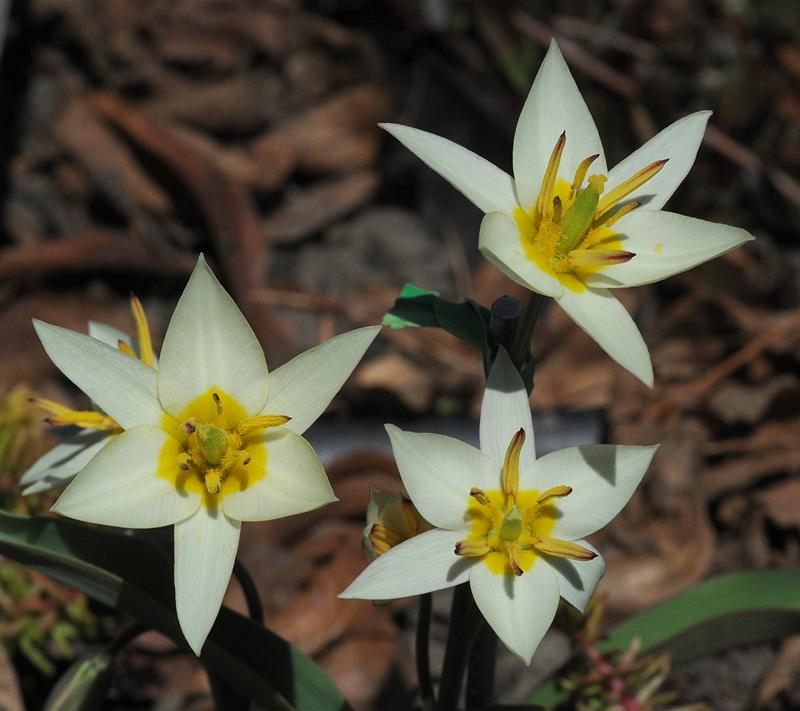

|
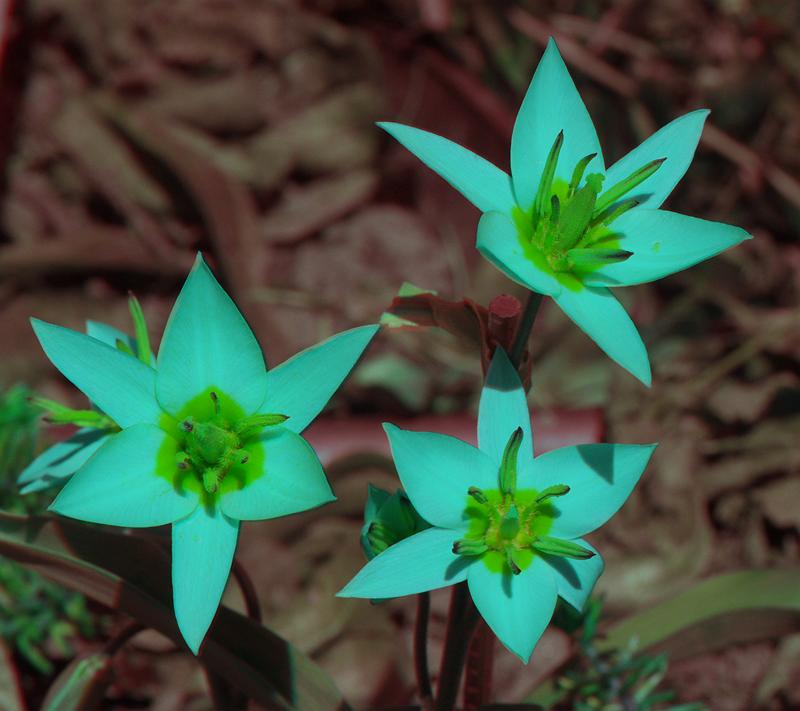

| |
| Tulipa 'Yokohama' is a short early hybrid. |
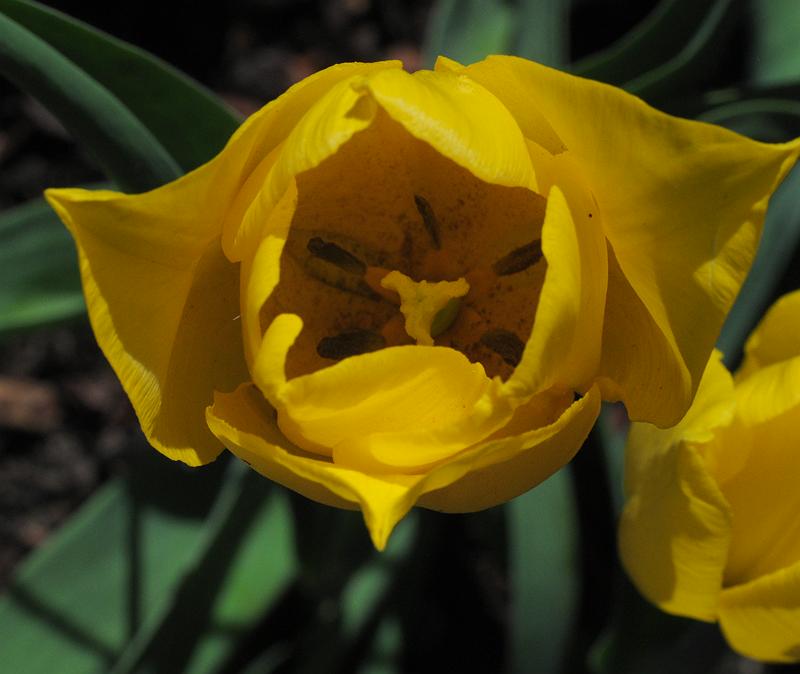

|
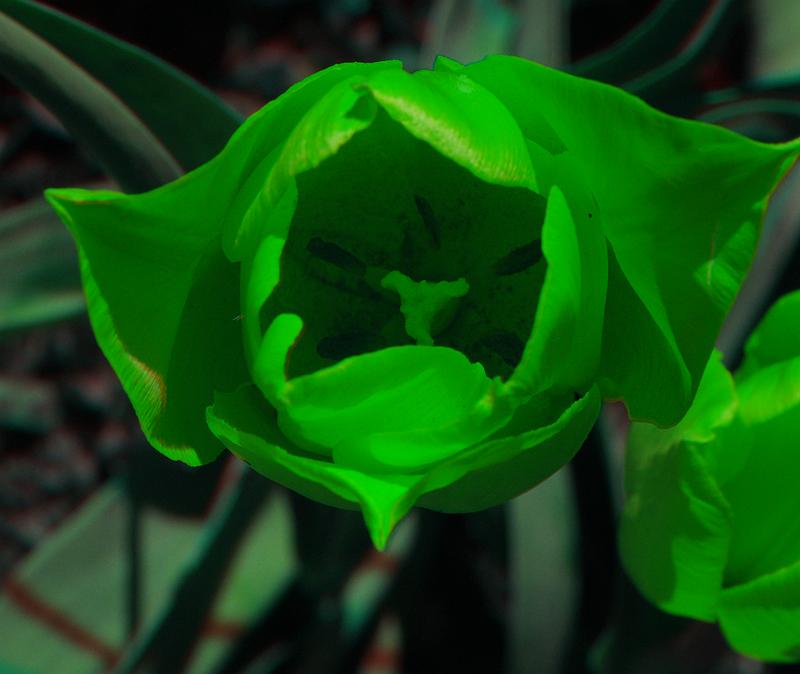

| |
| Uvularia grandiflora is native locally in mid shade woods with moist calcareous soil, and is doing well with 15% sun. |
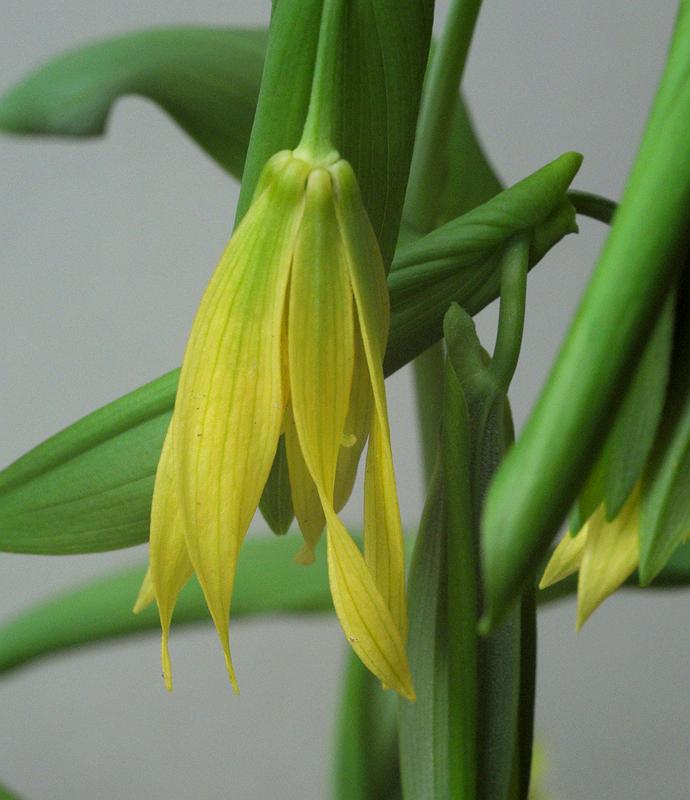

|
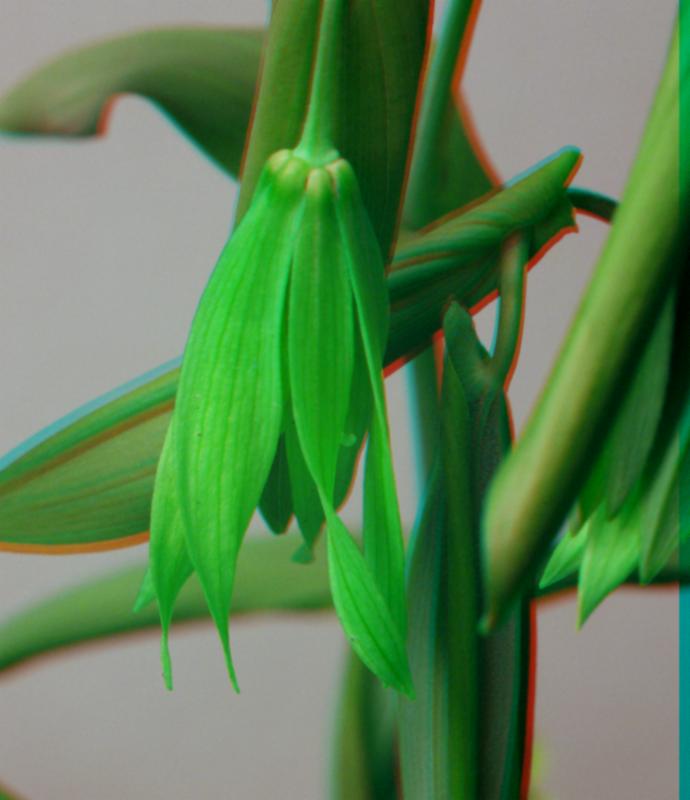

|
mouseover thumbnails for full images
human
insect
| Coreopsis verticillata 'Moonbeam' was moved from the back meadow where its sprawling habit didn't fit; against the side wall it forms a half mound with adequate blooms until hard frost. 1992 Perennial Plant of the Year, it's growing acceptably where it gets 40% sun but is failing in 20%. |
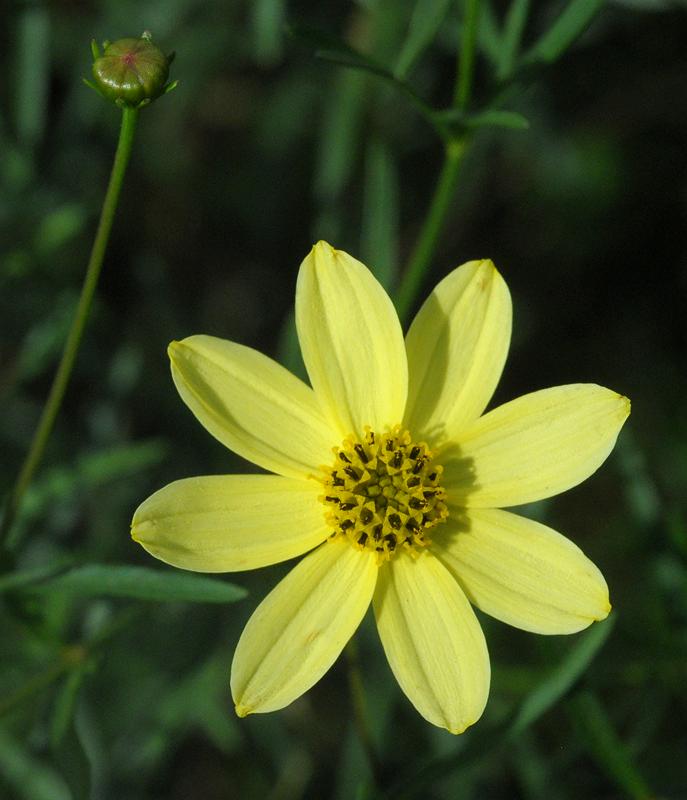

|
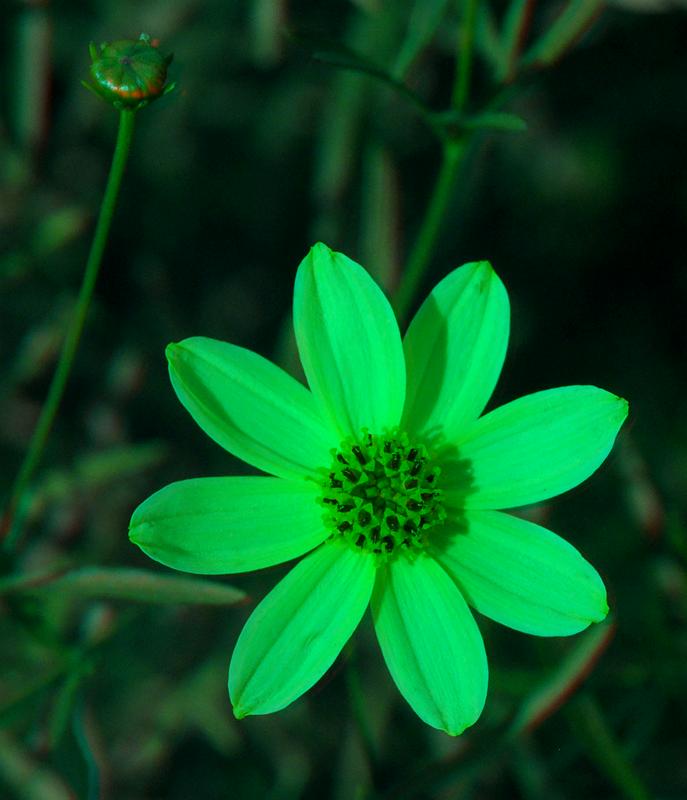

| |
| Potentilla neumanniana, native locally, covers the dry gravelly section in front of the garage. It's being outcompeted by Lotus corniculatus that arrived there by itself; 60-80% sun. |
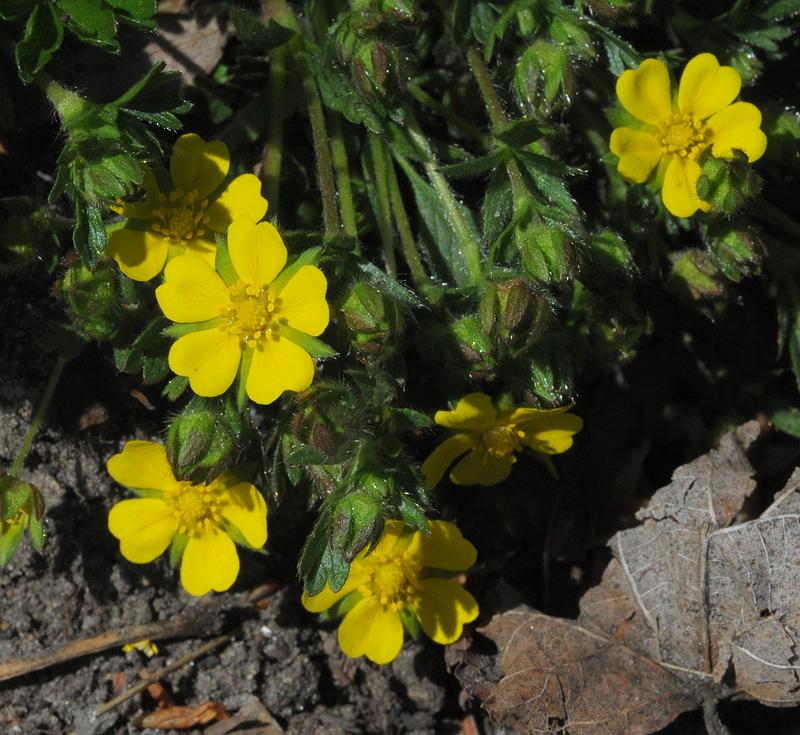

|
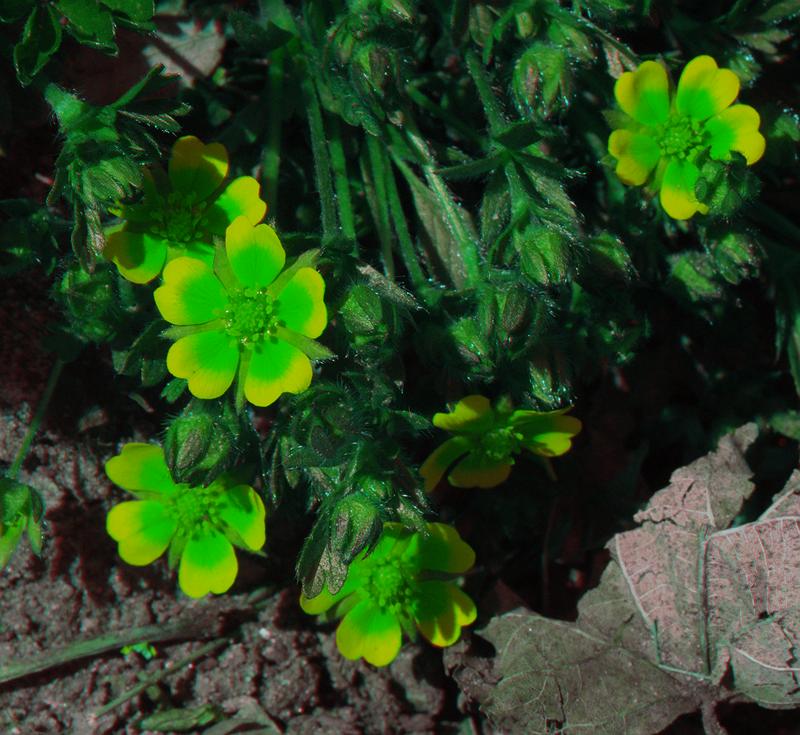

| |
| Sedum kamtschaticum is the ground cover under the Coreopsis; 20-40% sun. |


|


| |
| Zizia aptera, native to moist thickets and open woods of Ontario, was grown from seed. It multiplies well in tight clumps; flower diameter 1 mm; 50% sun. |
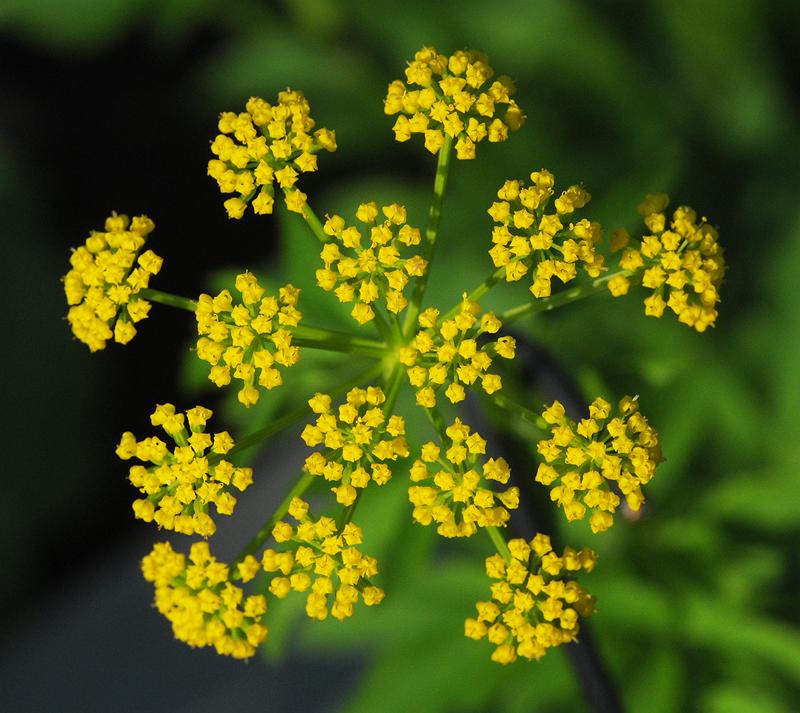

|
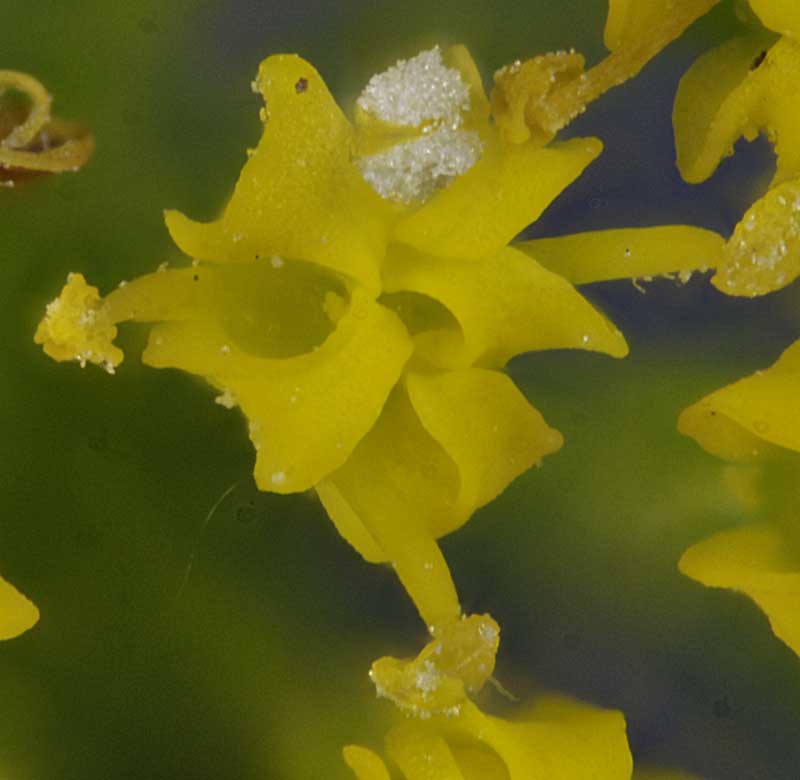

|
| small Cruciferae: many small-flowered members of the mustard family are naturalized locally; Barbarea vulgaris, Brassica kaber, B.nigra and Erysimum cheiranthoides are the most common; flower diameters 5-15 mm. |
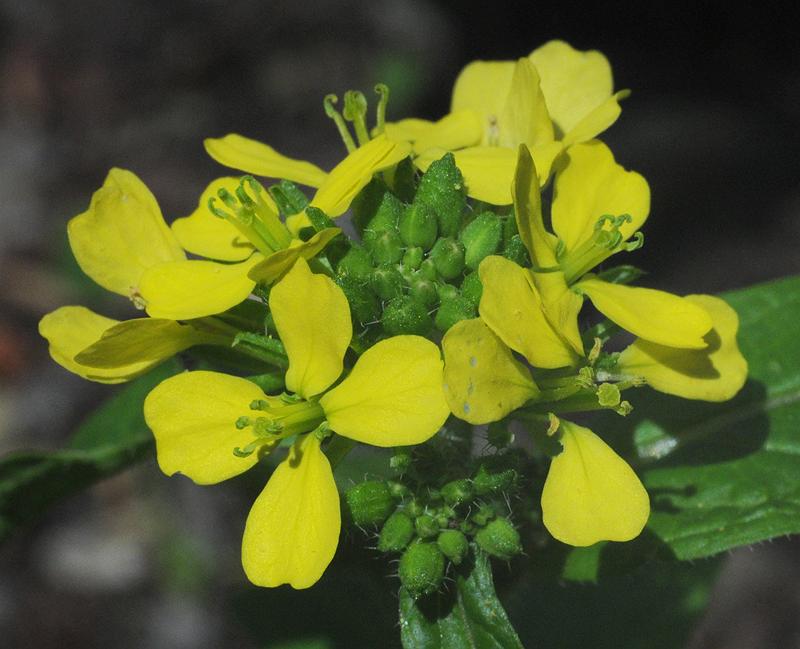
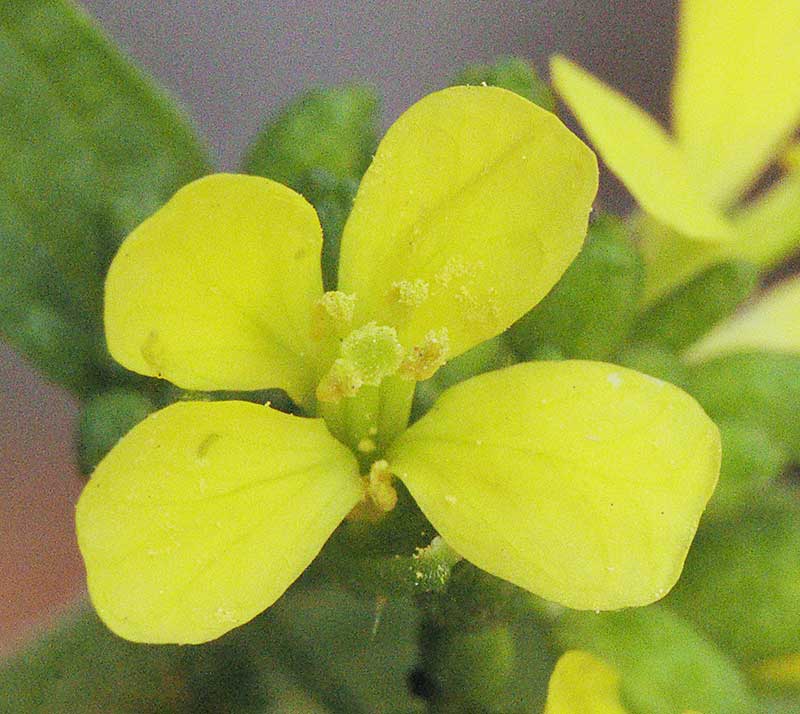
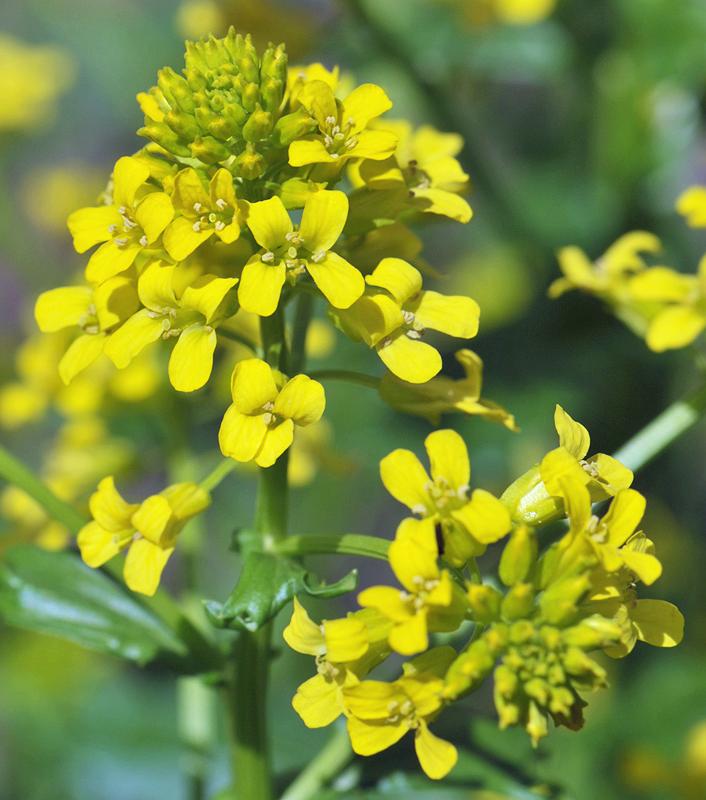
|
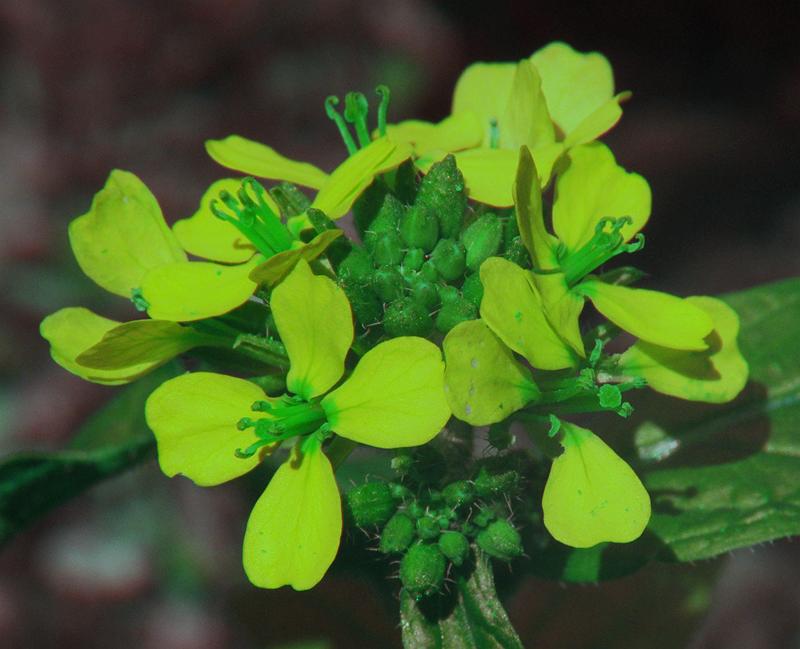
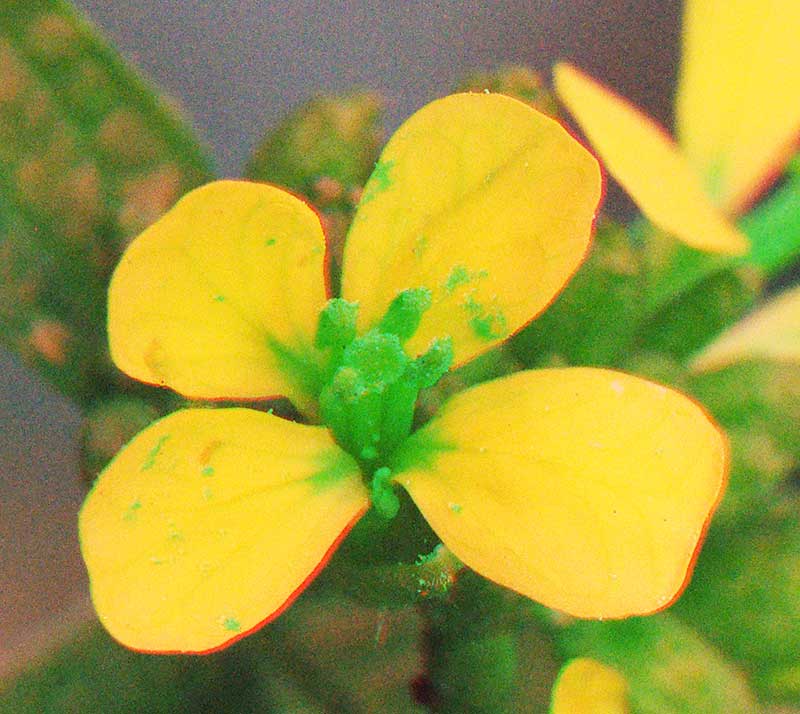
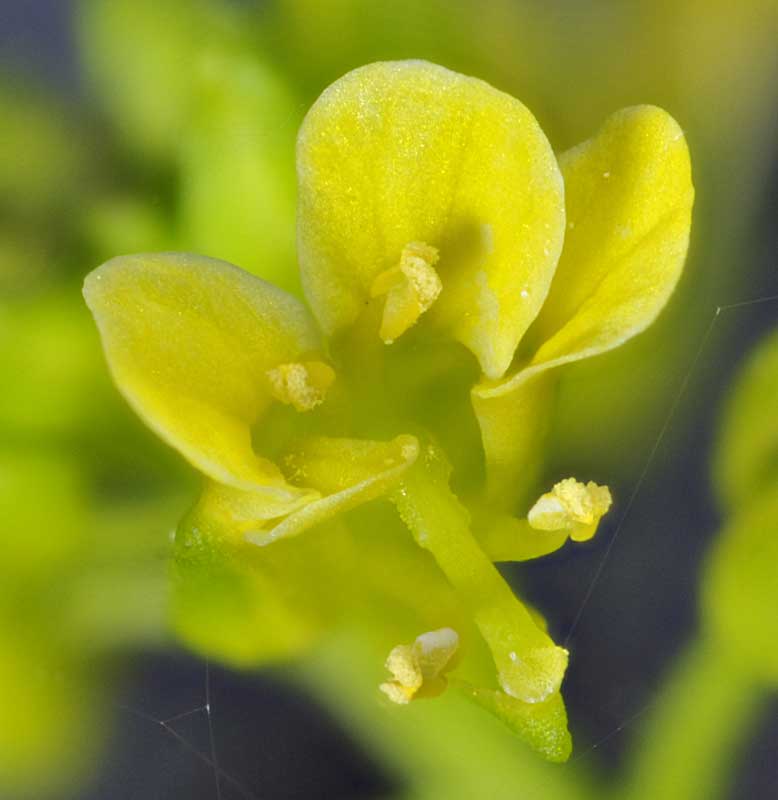
| |
| Oxalis stricta is native locally and pops up in any empty spot; it's easily pulled up where not wanted; flower diameter 7 mm. |
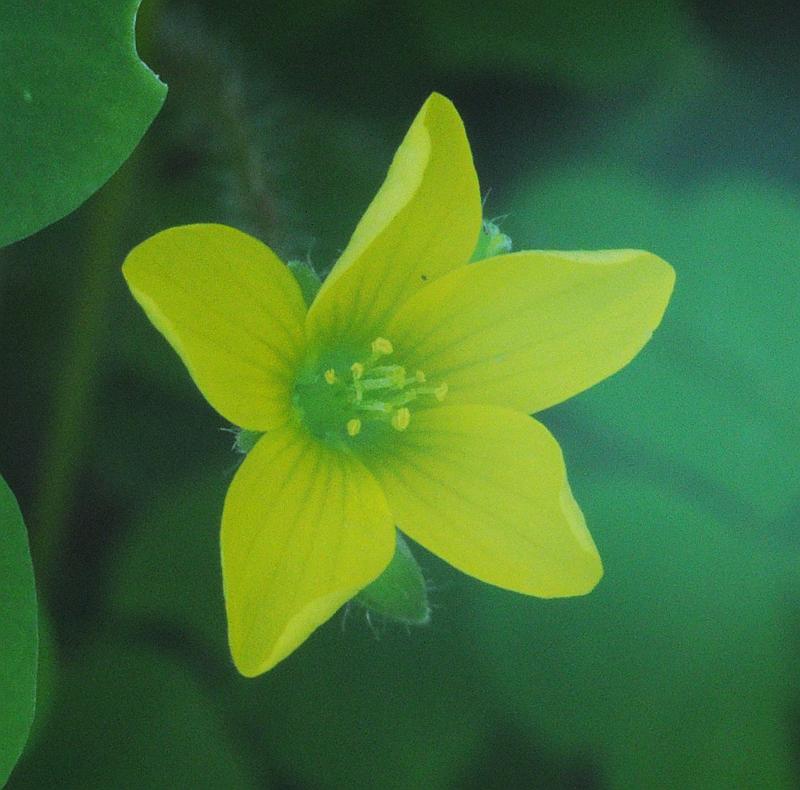

|
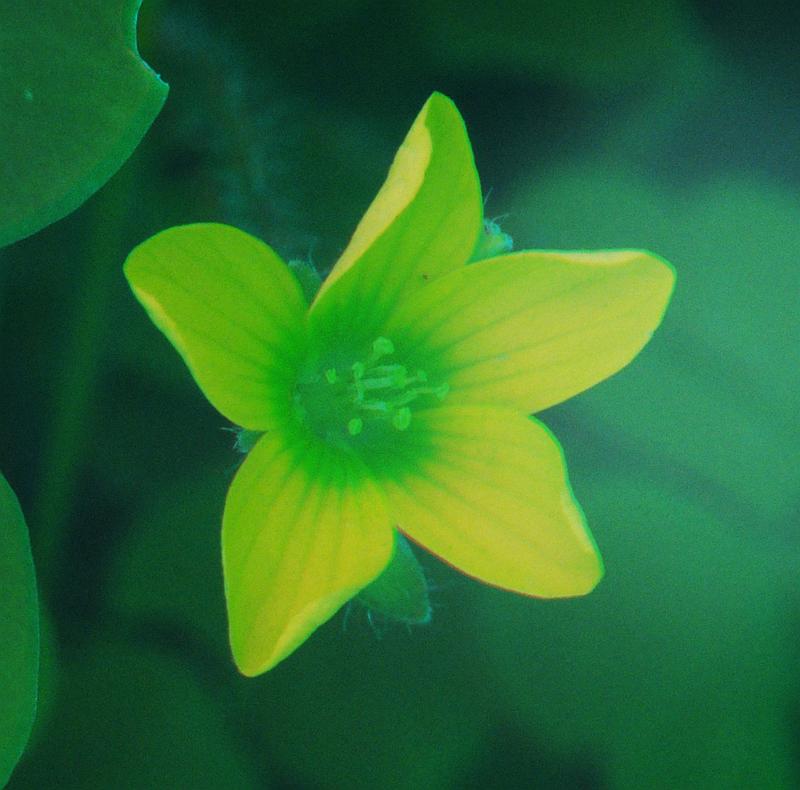

| |
| Potentilla argentea from temperate Asia is widely naturalized locally as a medium-lived perennial. Its blooms appear as sparkles over the L.nummularia leaves; flower diameter 9 mm. |
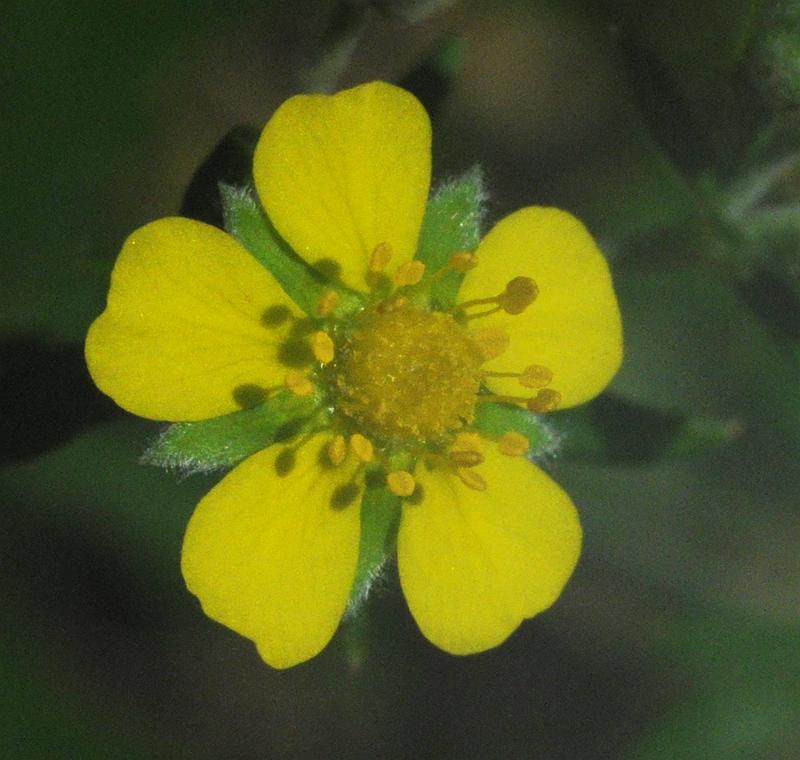

|
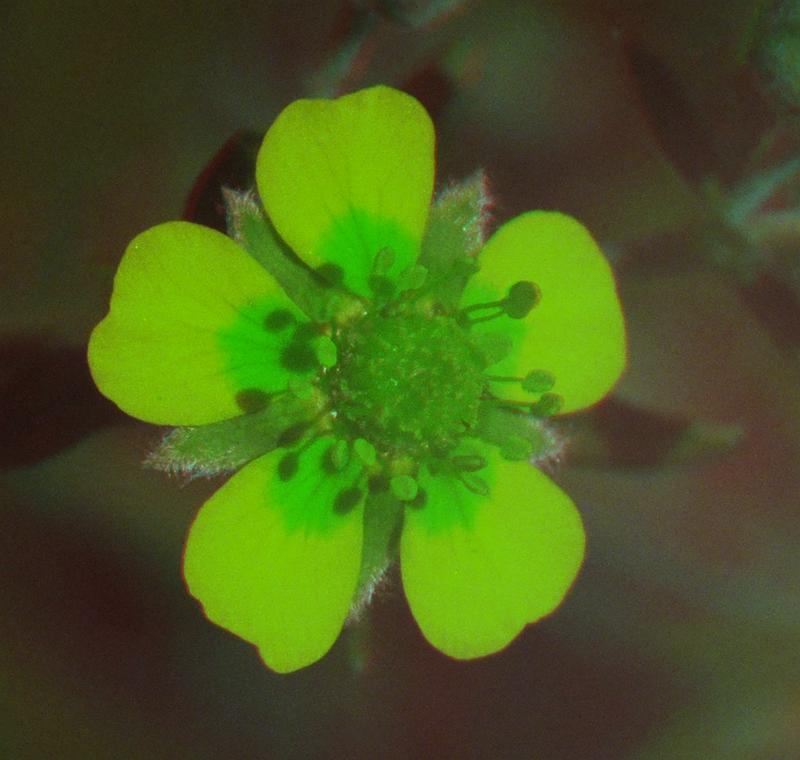

| |
| Ranunculus abortivus is native but rare; flower diameter 8 mm. |
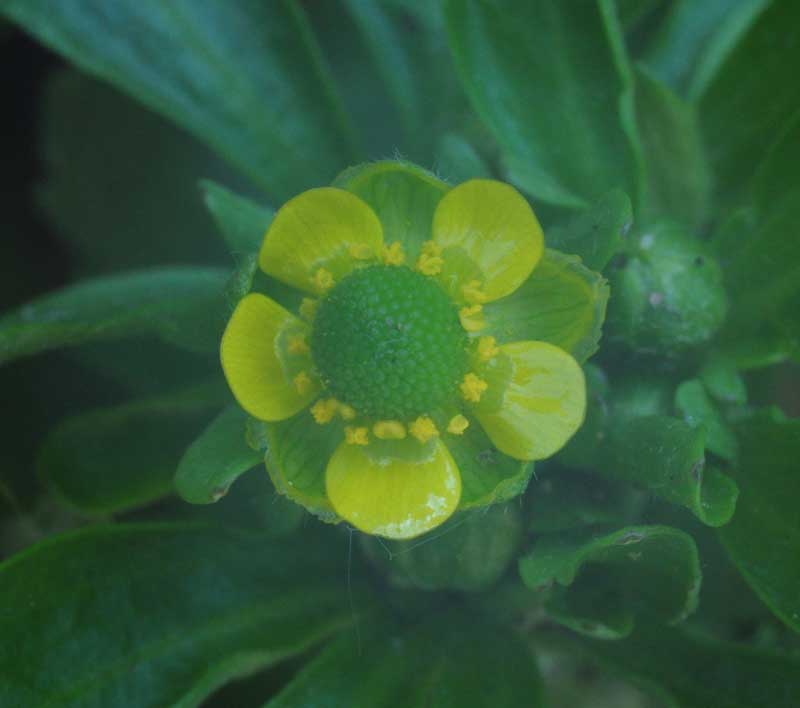

|
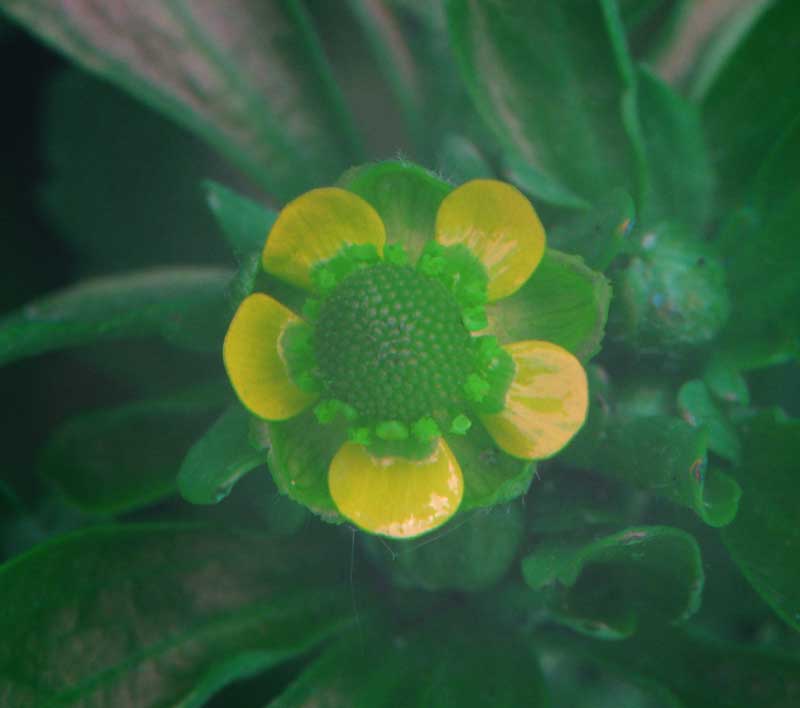

| |
| Taraxacum officinale from Eurasia has become naturalized throughout the continent, including on my neighbour's lawn. I keep a few in the back garden and deadhead them to keep them from spreading out of control. It's a beautiful flower to all except those who demand that lawns look like plastic; composite diameter 35 mm; 20-80% sun. |
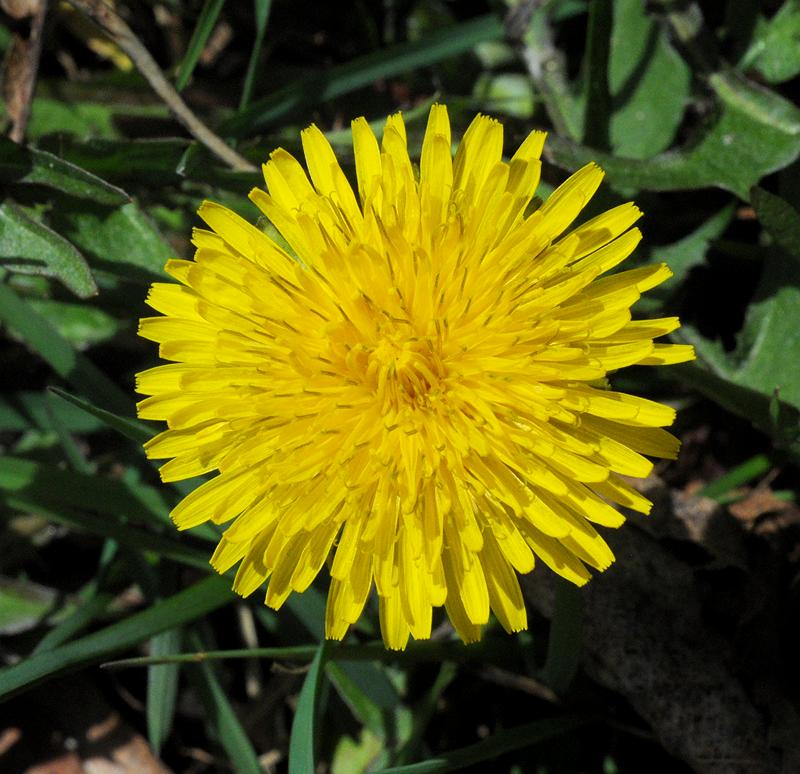

|
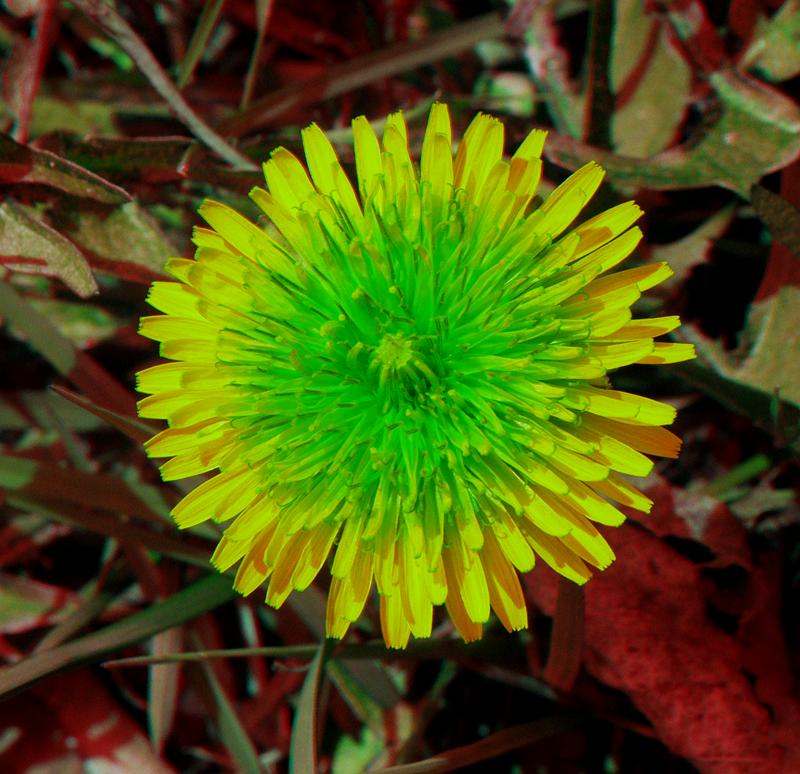

| |
| Trifolium agrarium (including related hop clovers and Medicago lupulina) from Eurasia have become naturalized throughout the continent, they grow among the Lotus corniculatus adjacent to the front sidewalk. Composite diameter 6 mm; 80% sun. |
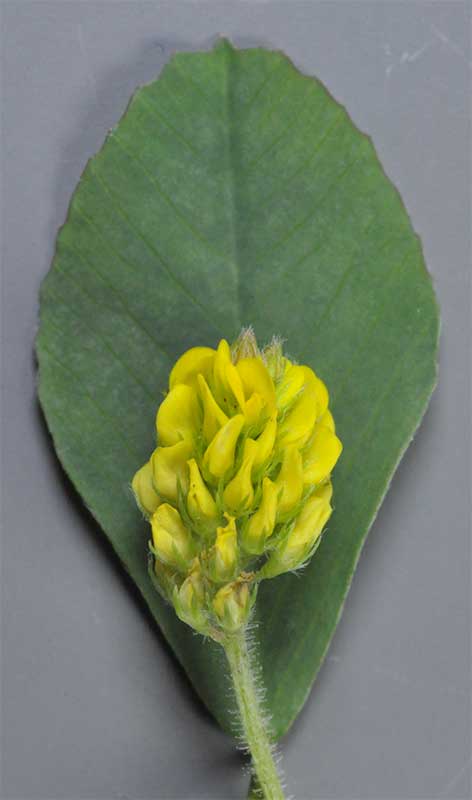

|
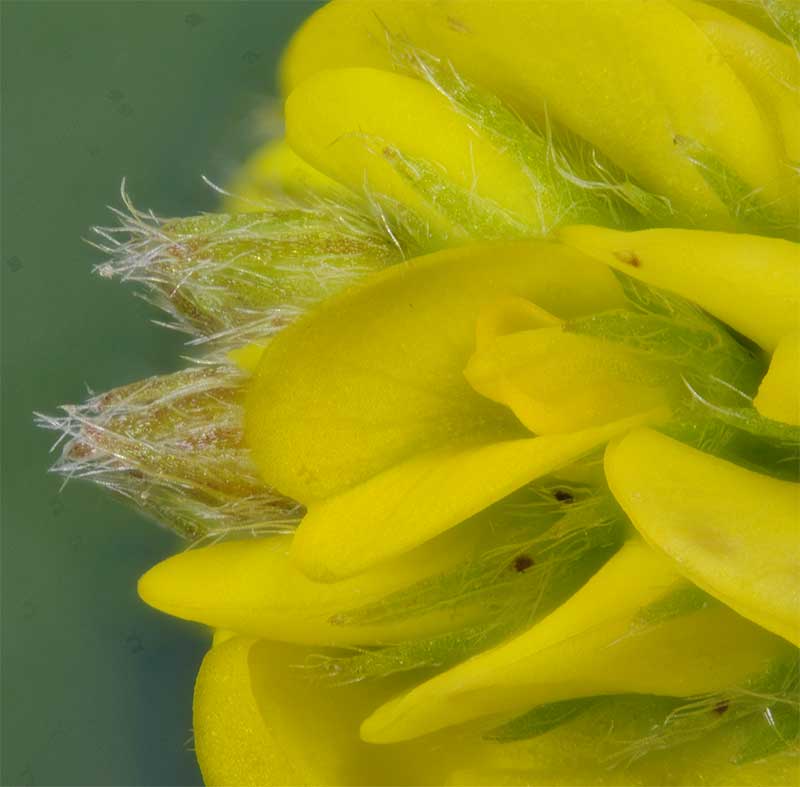

|